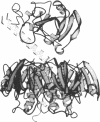Abstract
Cholera and the related Escherichia coli-associated diarrheal disease are important problems confronting Third World nations and any area where water supplies can become contaminated. The disease is extremely debilitating and may be fatal in the absence of treatment. Symptoms are caused by the action of cholera toxin, secreted by the bacterium Vibrio cholerae, or by a closely related heat-labile enterotoxin, produced by Escherichia coli, that causes a milder, more common traveler's diarrhea. Both toxins bind receptors in intestinal epithelial cells and insert an enzymatic subunit that modifies a G protein associated with the adenylate cyclase complex. The consequent stimulated production of cyclic AMP, or other factors such as increased synthesis of prostaglandins by intoxicated cells, initiates a metabolic cascade that results in the excessive secretion of fluid and electrolytes characteristic of the disease. The toxins have a very high degree of structural and functional homology and may be evolutionarily related. Several effective new vaccine formulations have been developed and tested, and a growing family of endogenous cofactors is being discovered in eukaryotic cells. The recent elucidation of the three-dimensional structure of the heat-labile enterotoxin has provided an opportunity to examine and compare the correlations between structure and function of the two toxins. This information may improve our understanding of the disease process itself, as well as illuminate the role of the toxin in studies of signal transduction and G-protein function.
Full text
PDF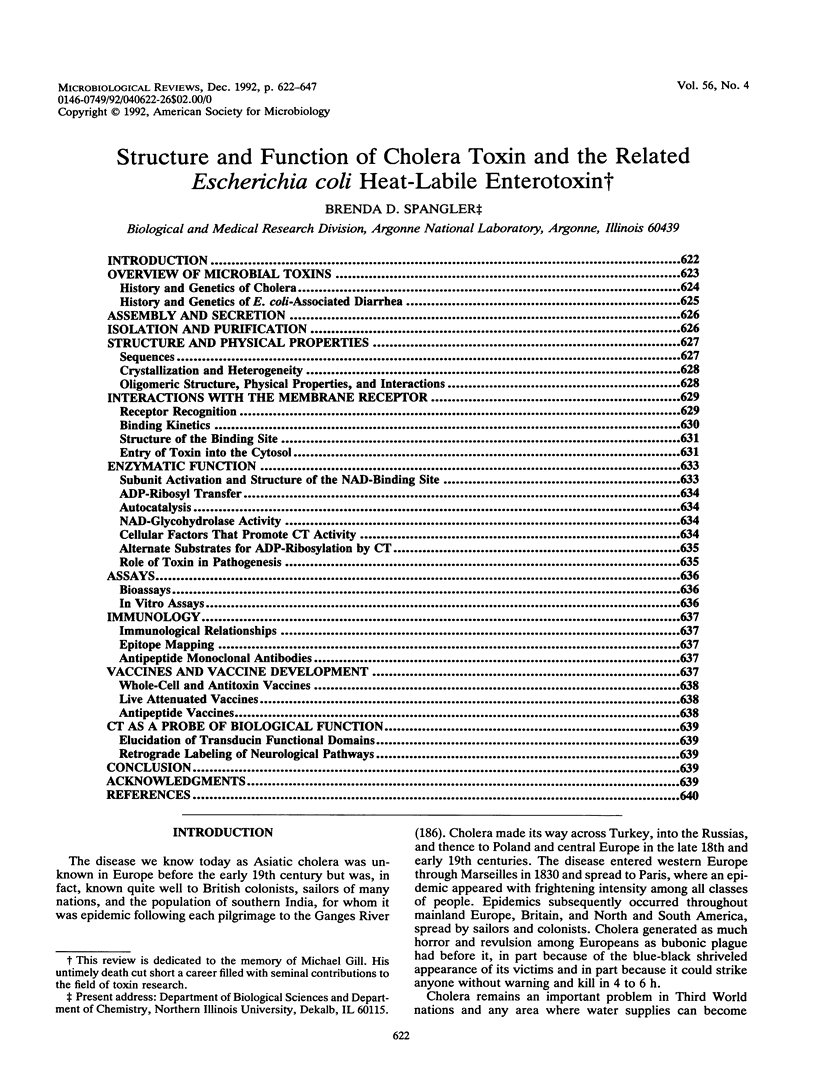
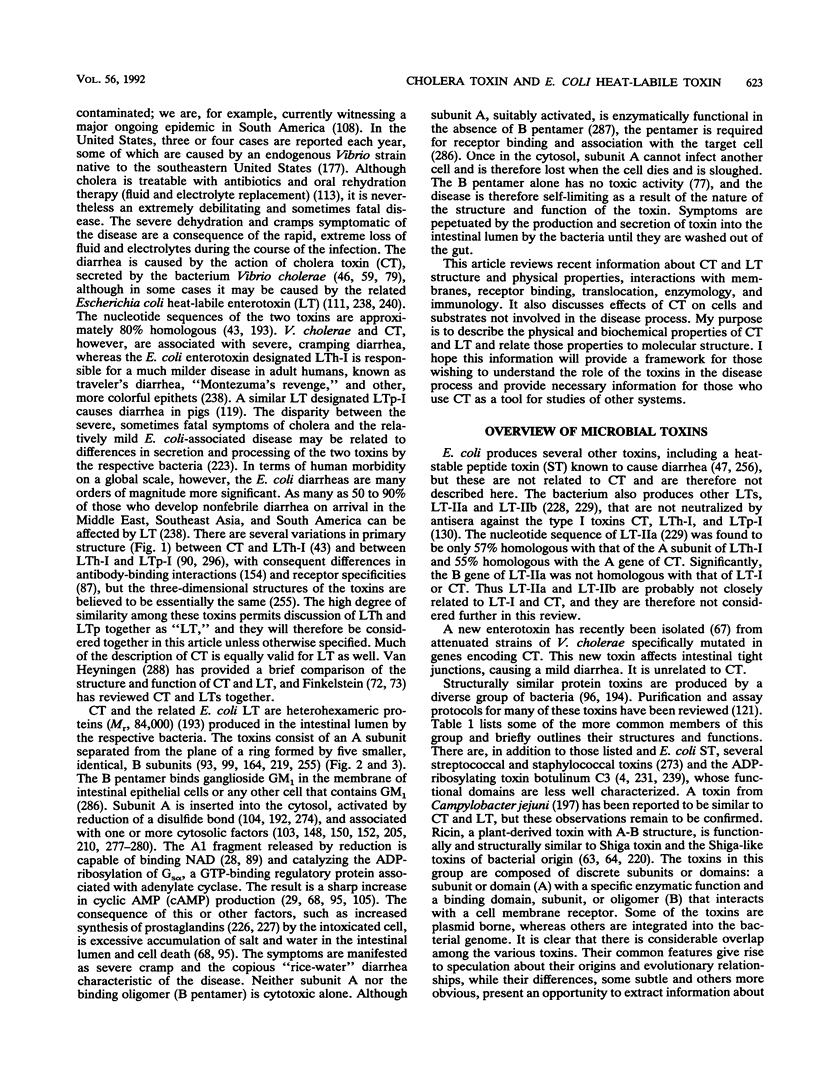
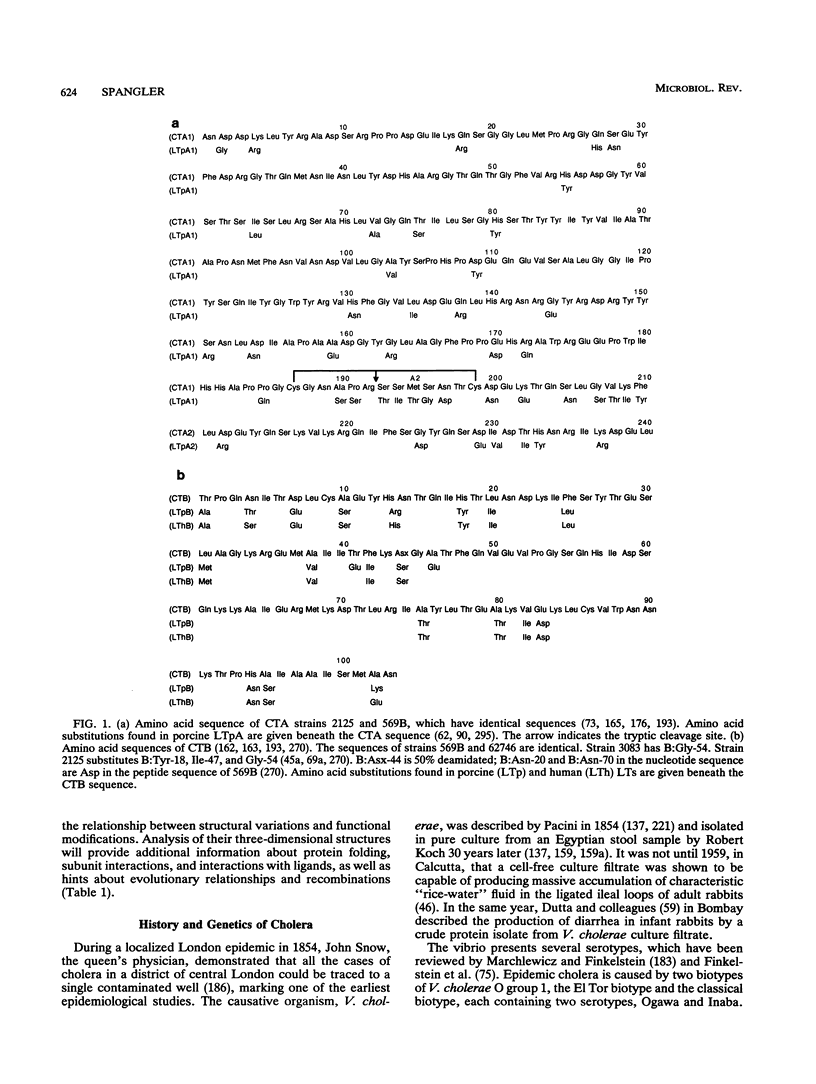
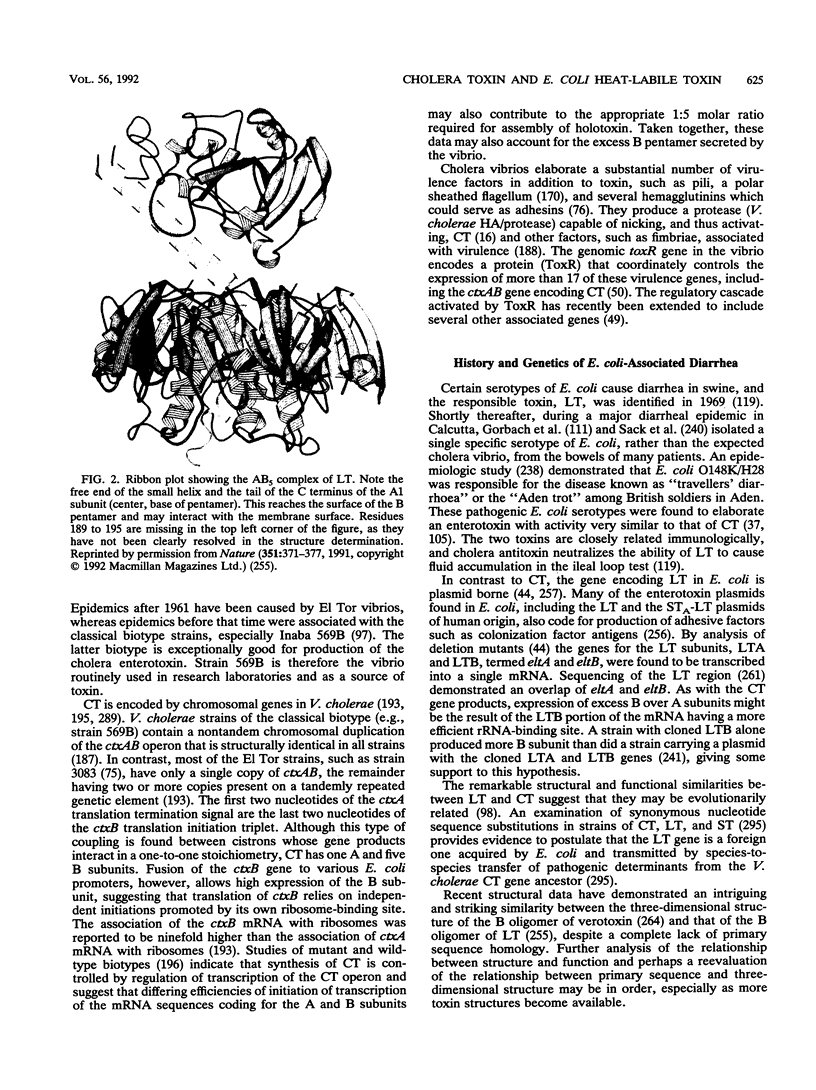
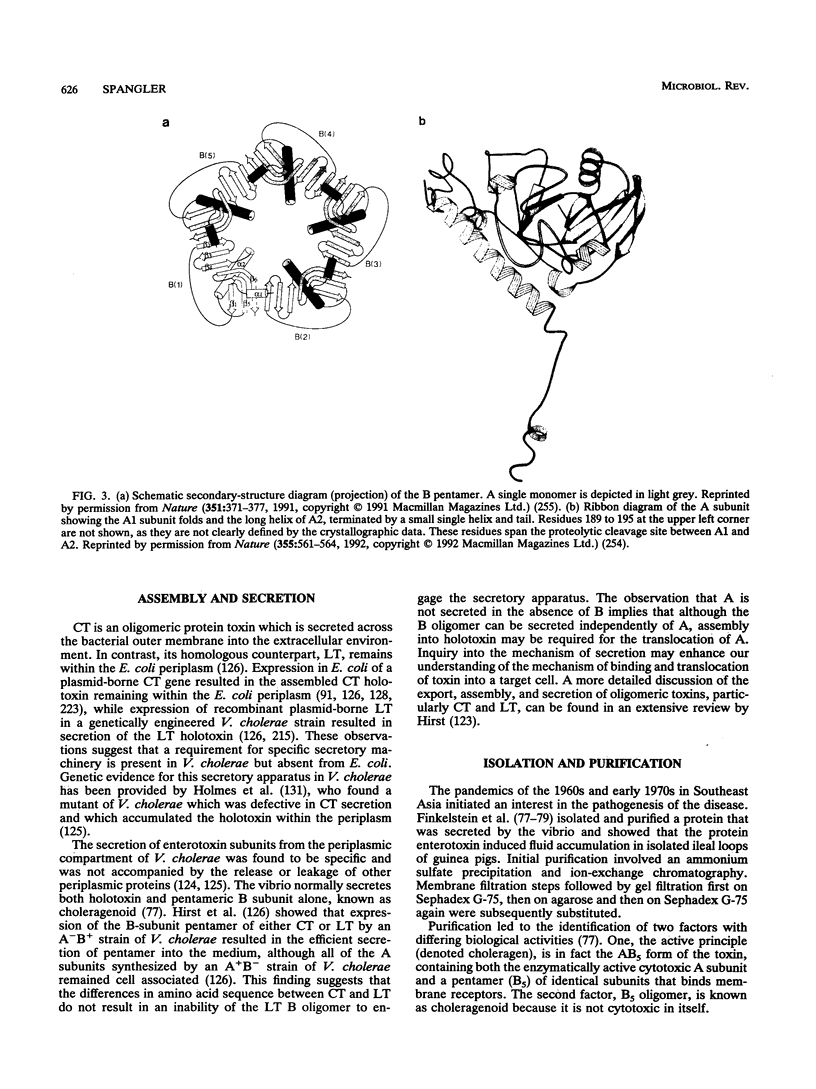
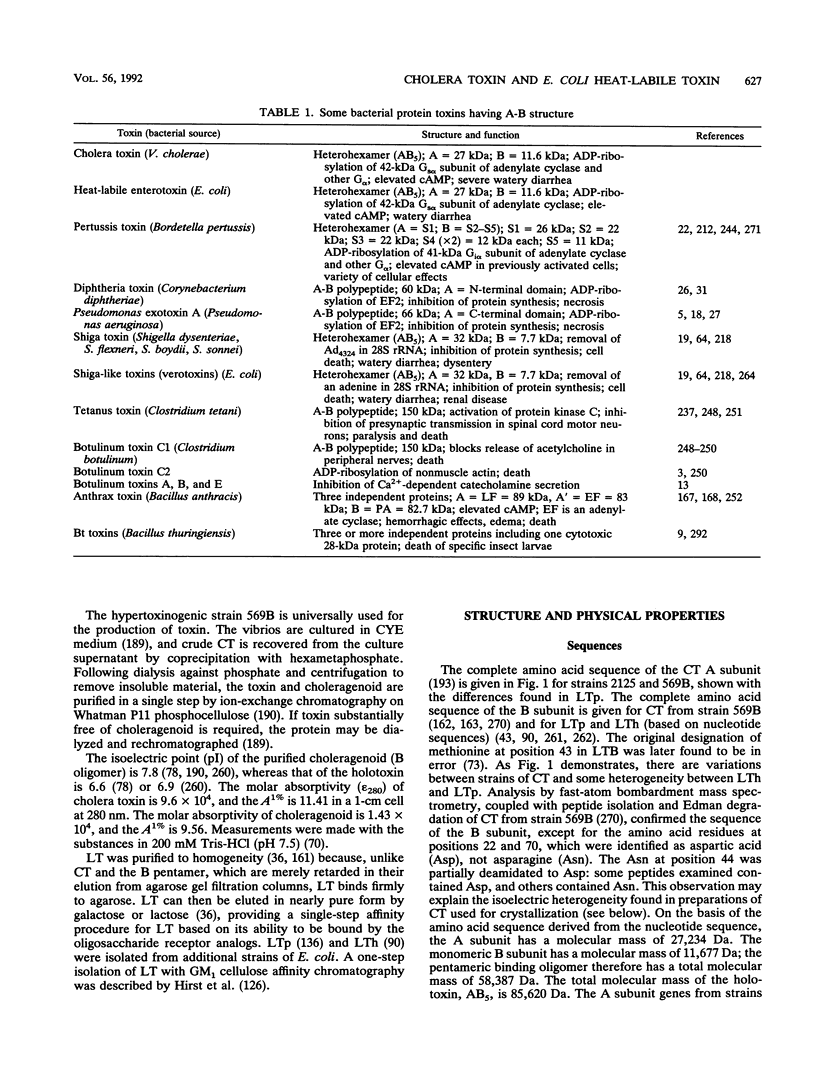

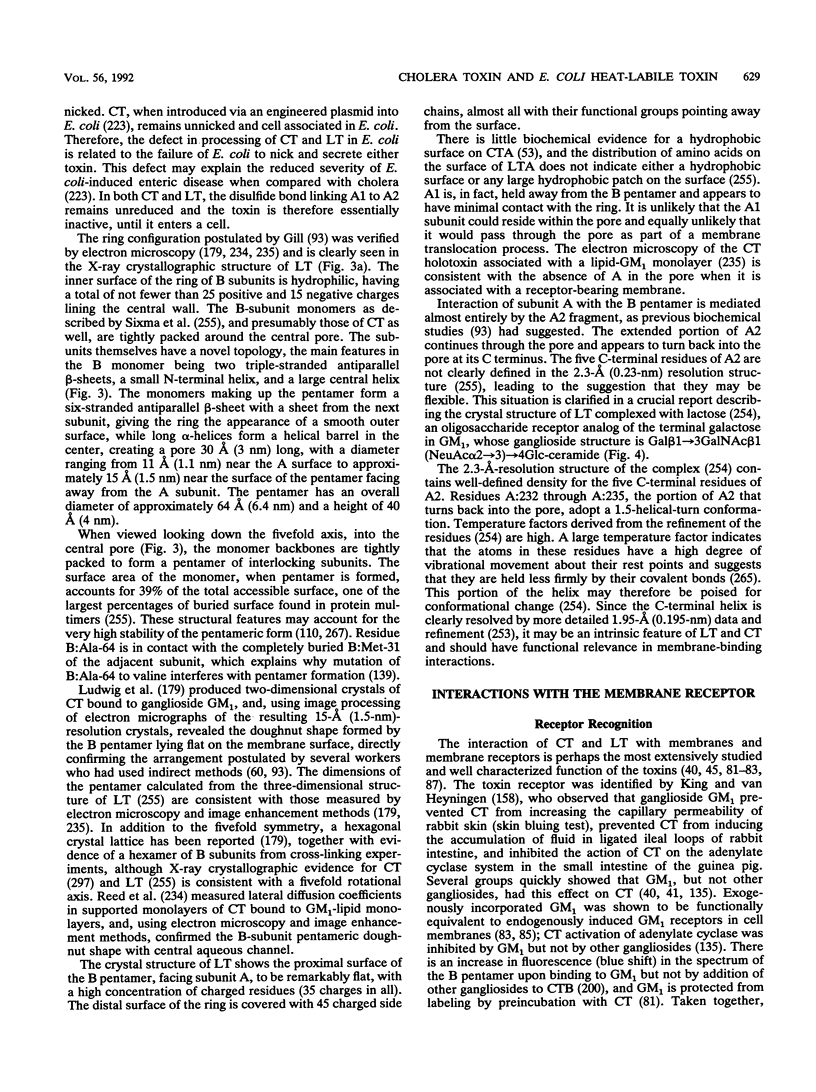
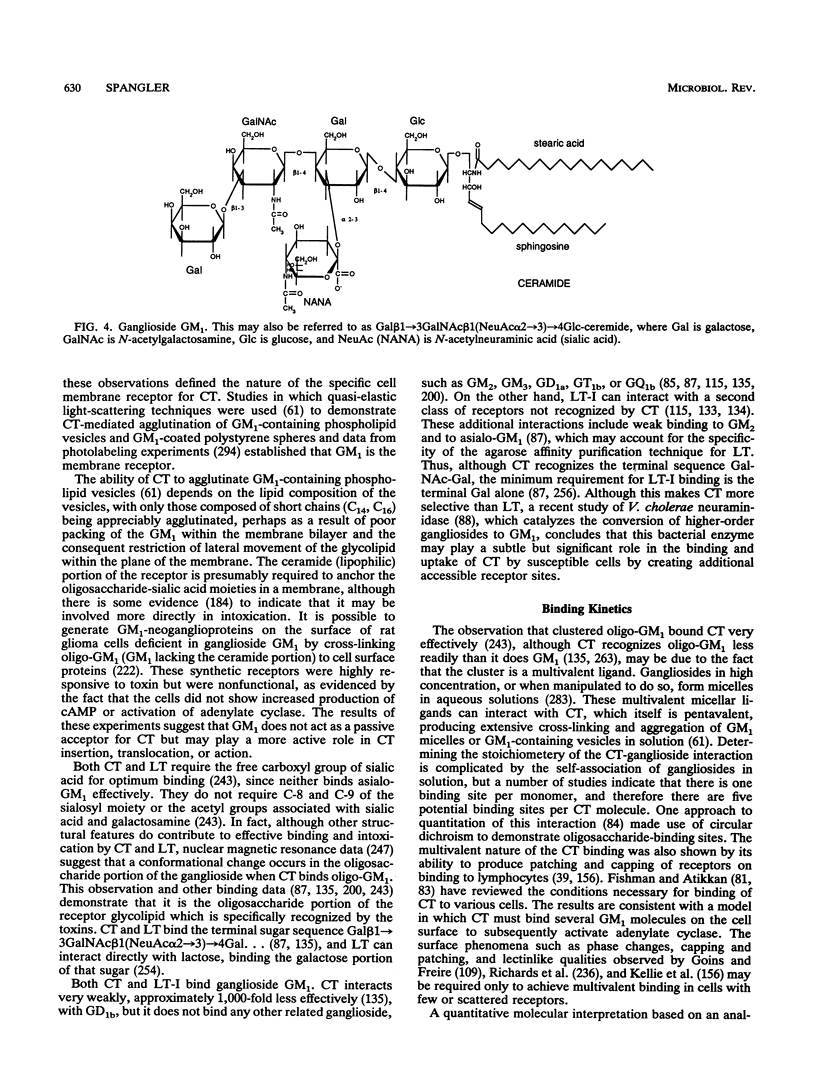
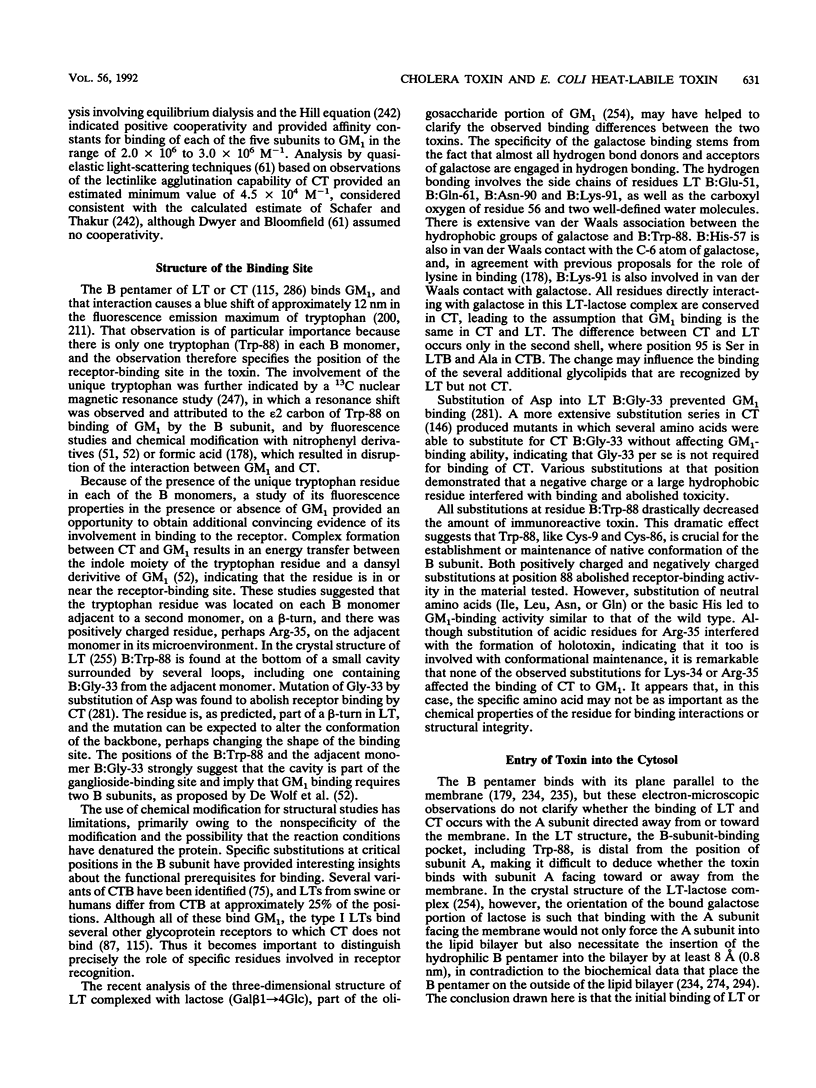
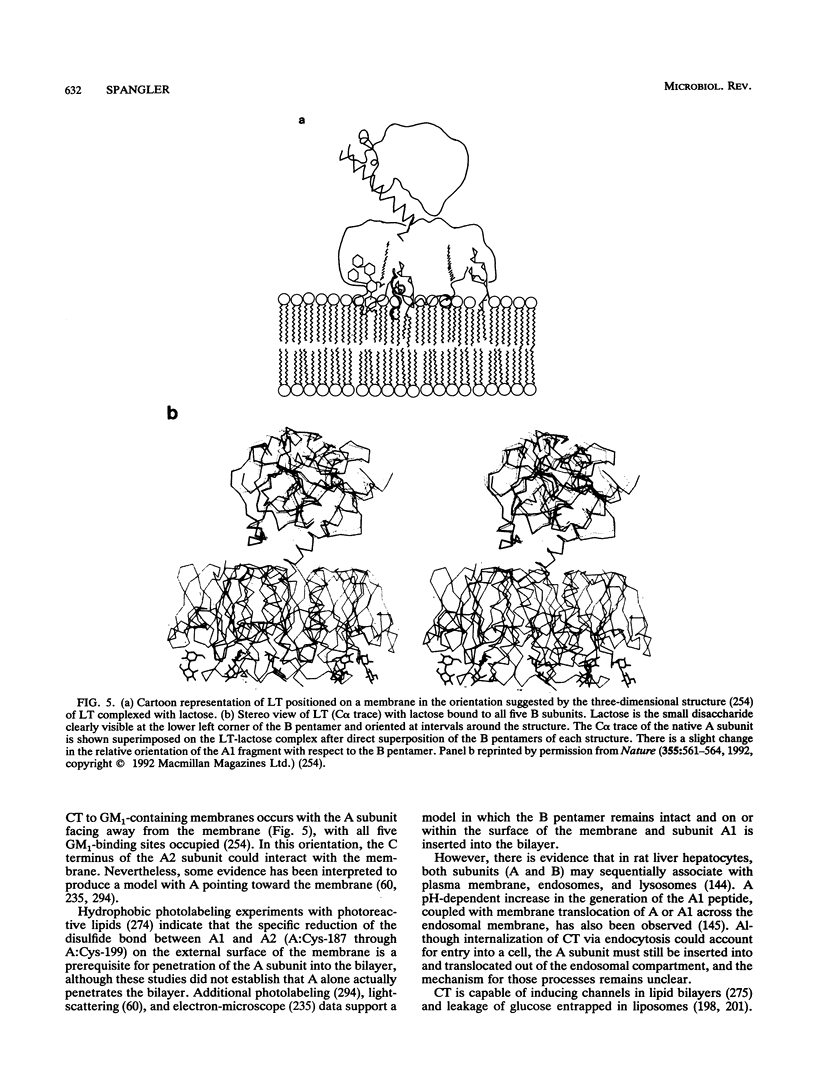
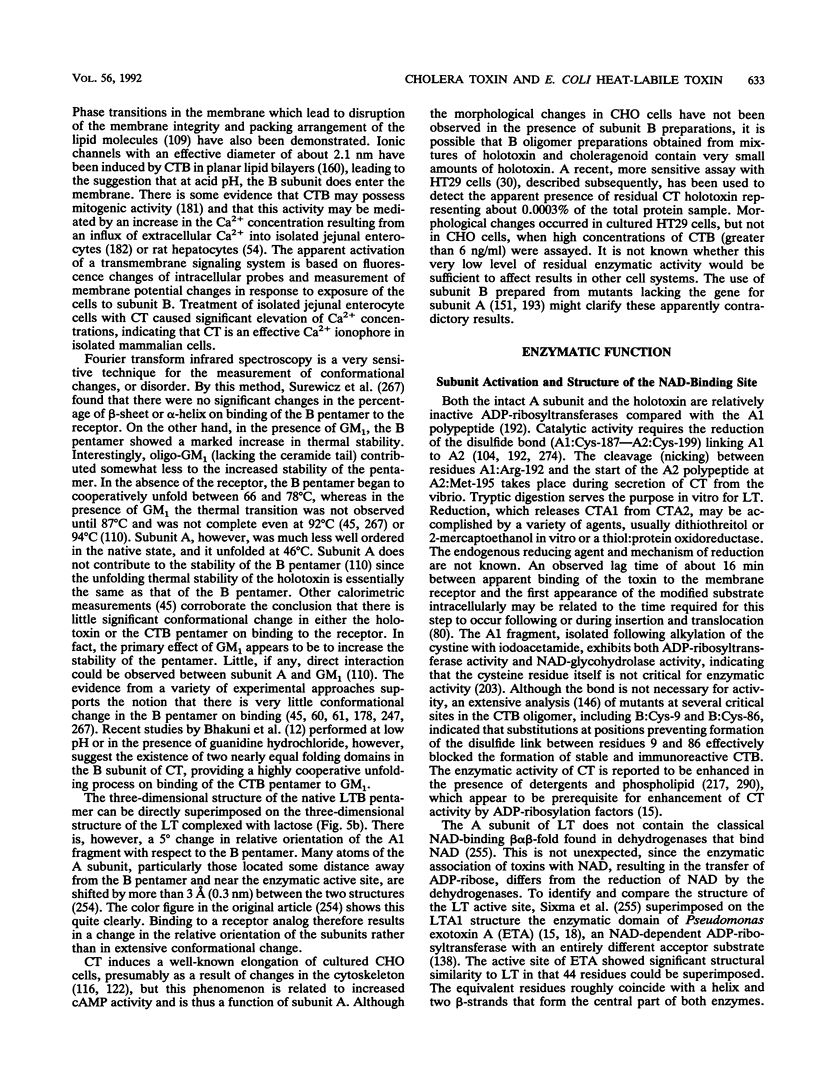
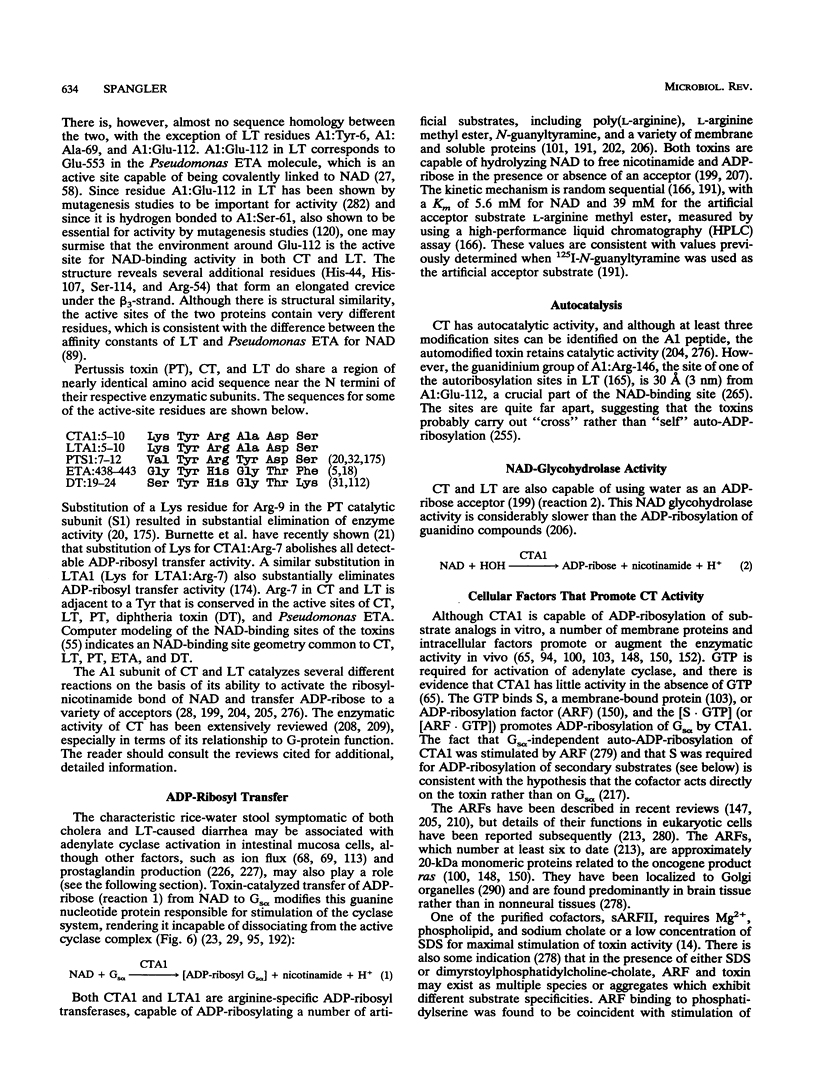
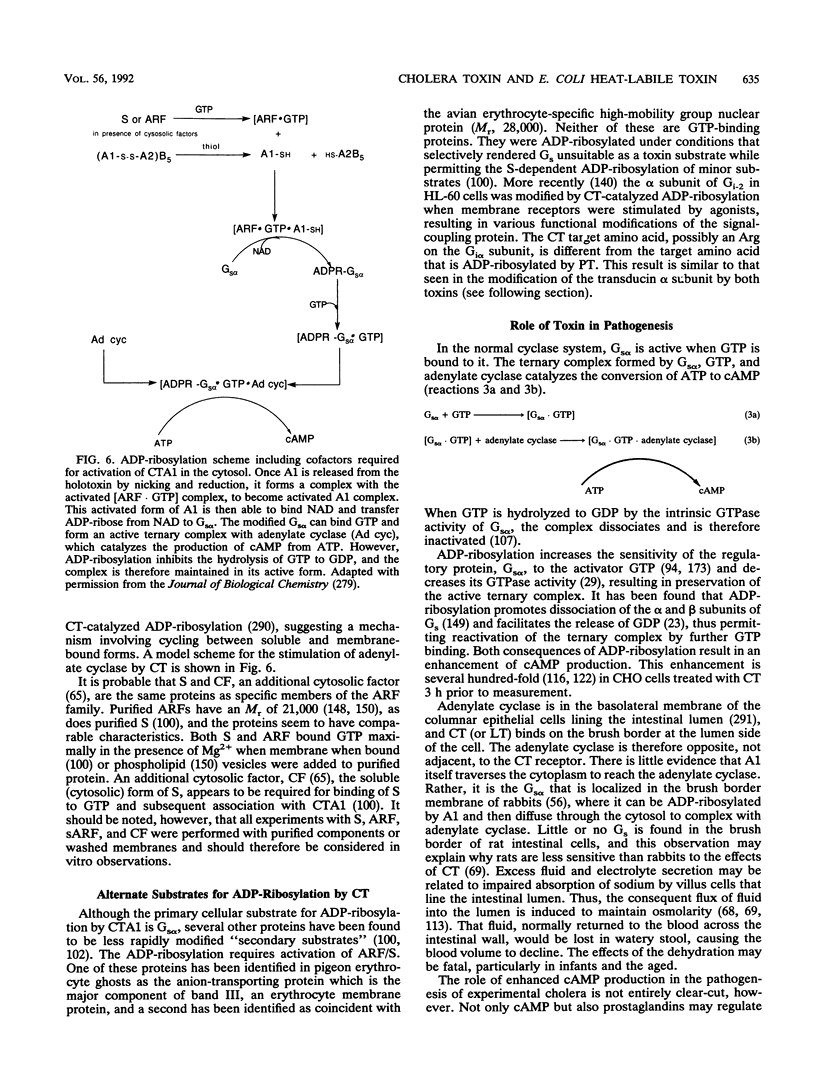
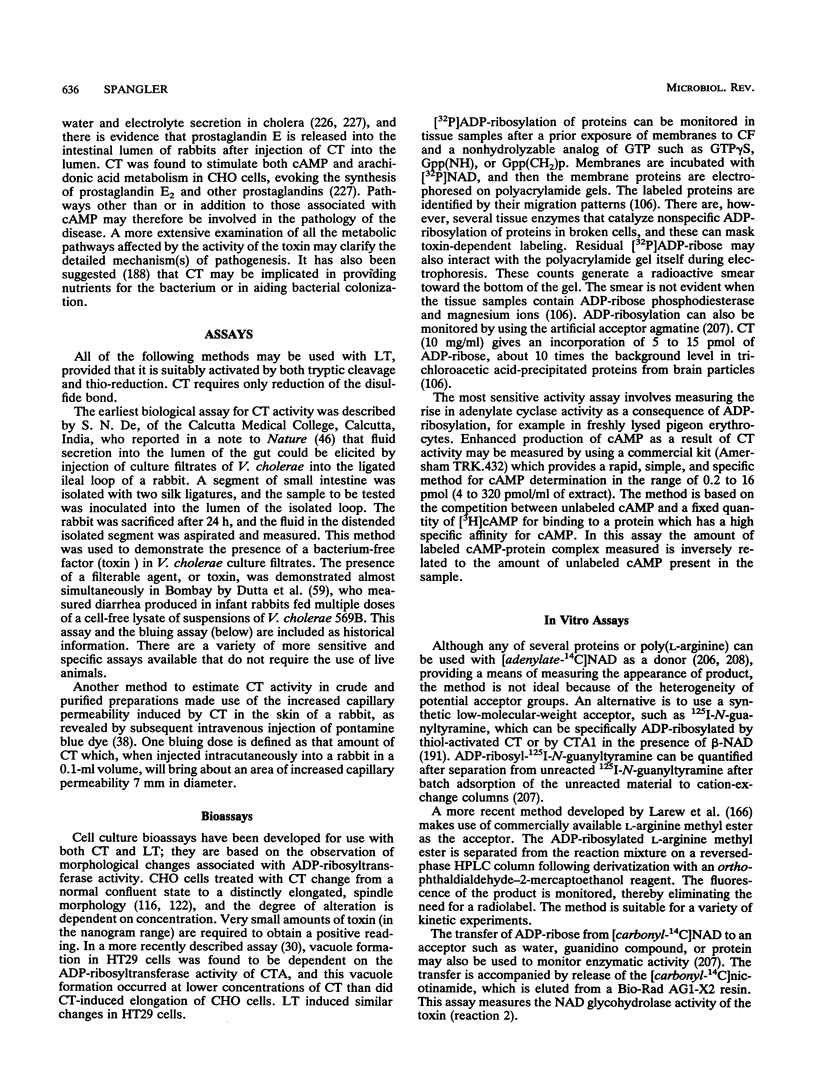
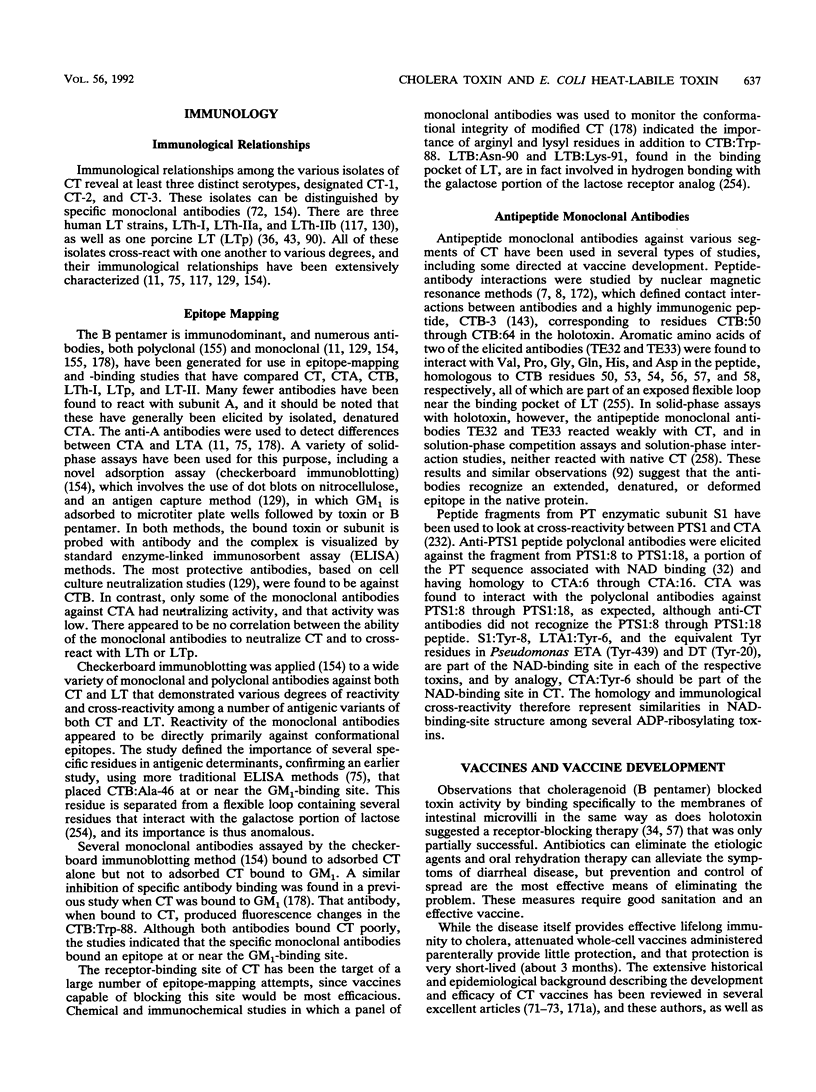
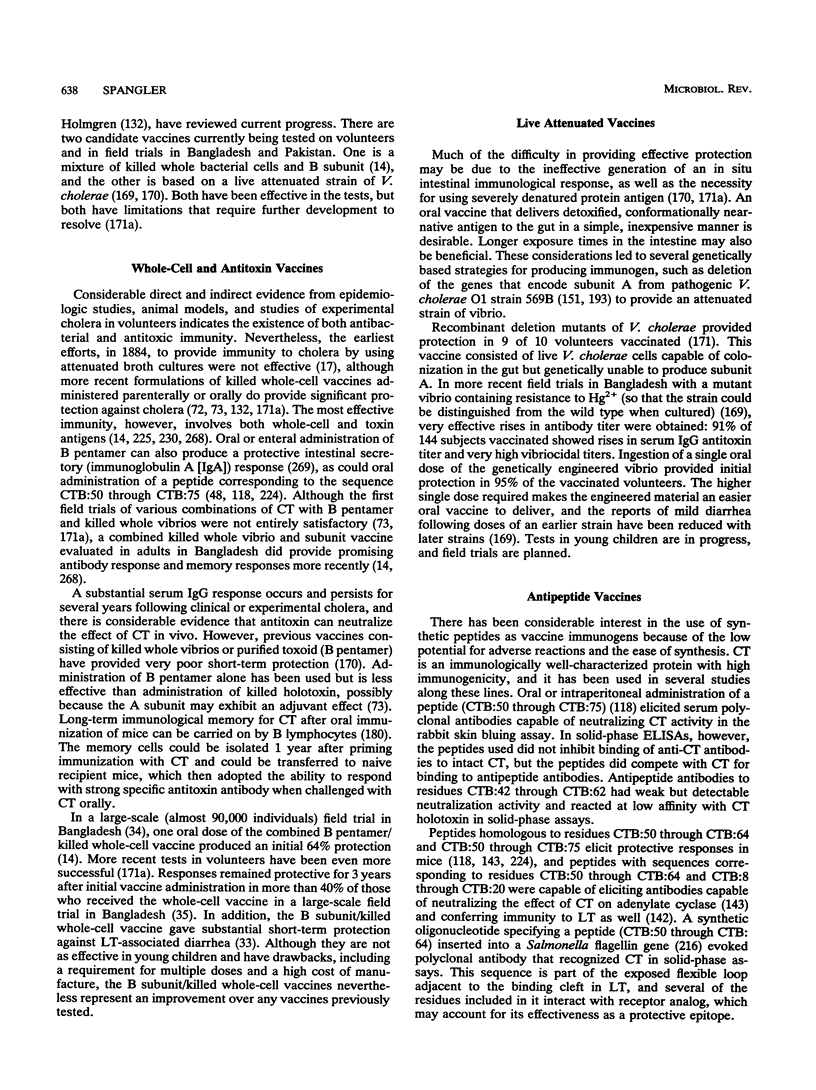
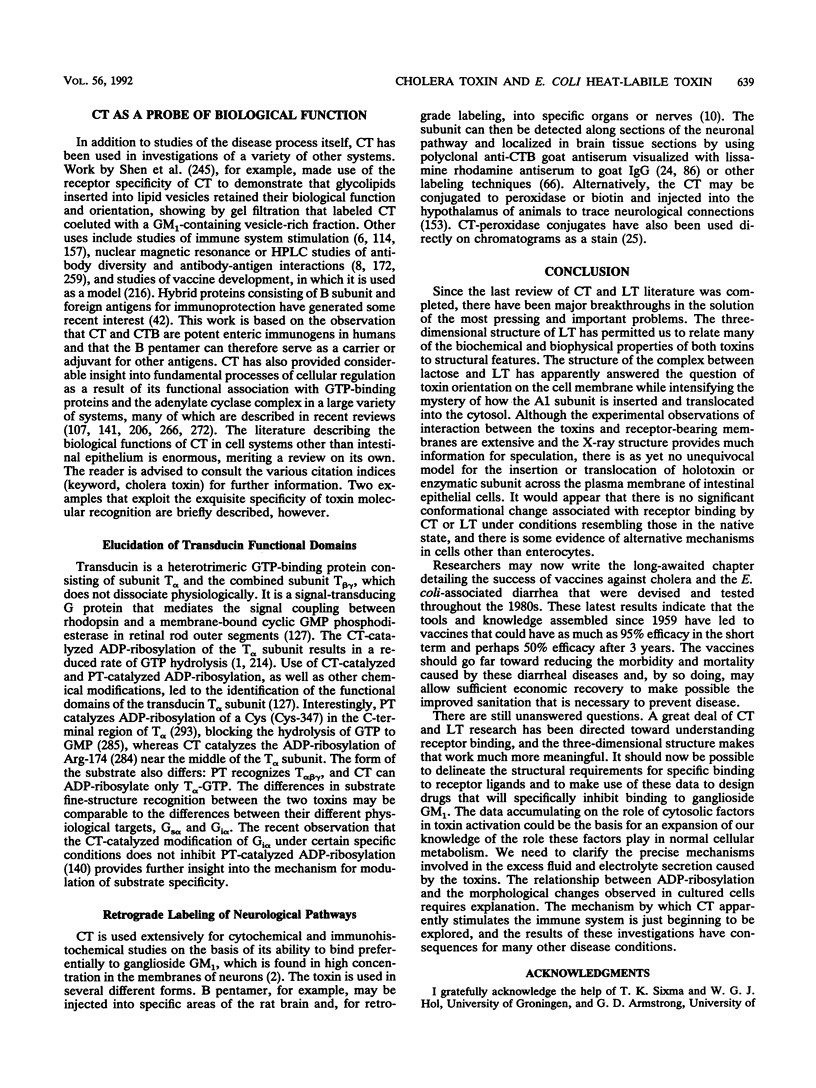

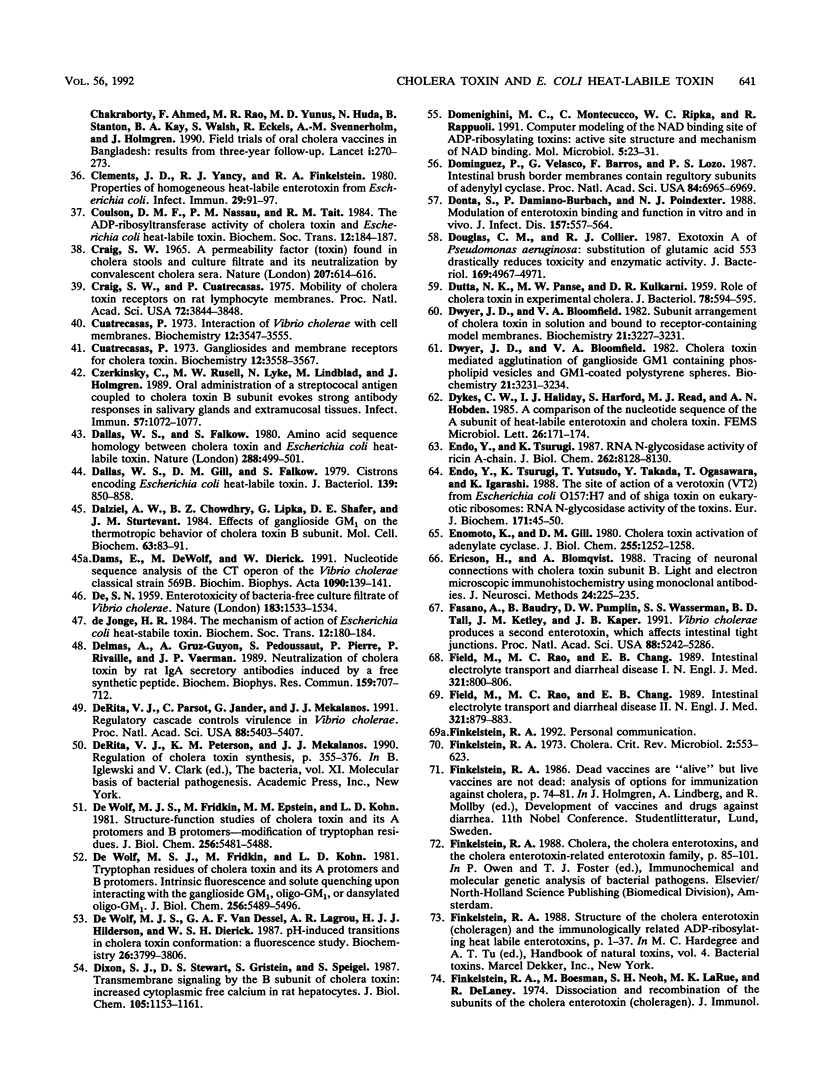
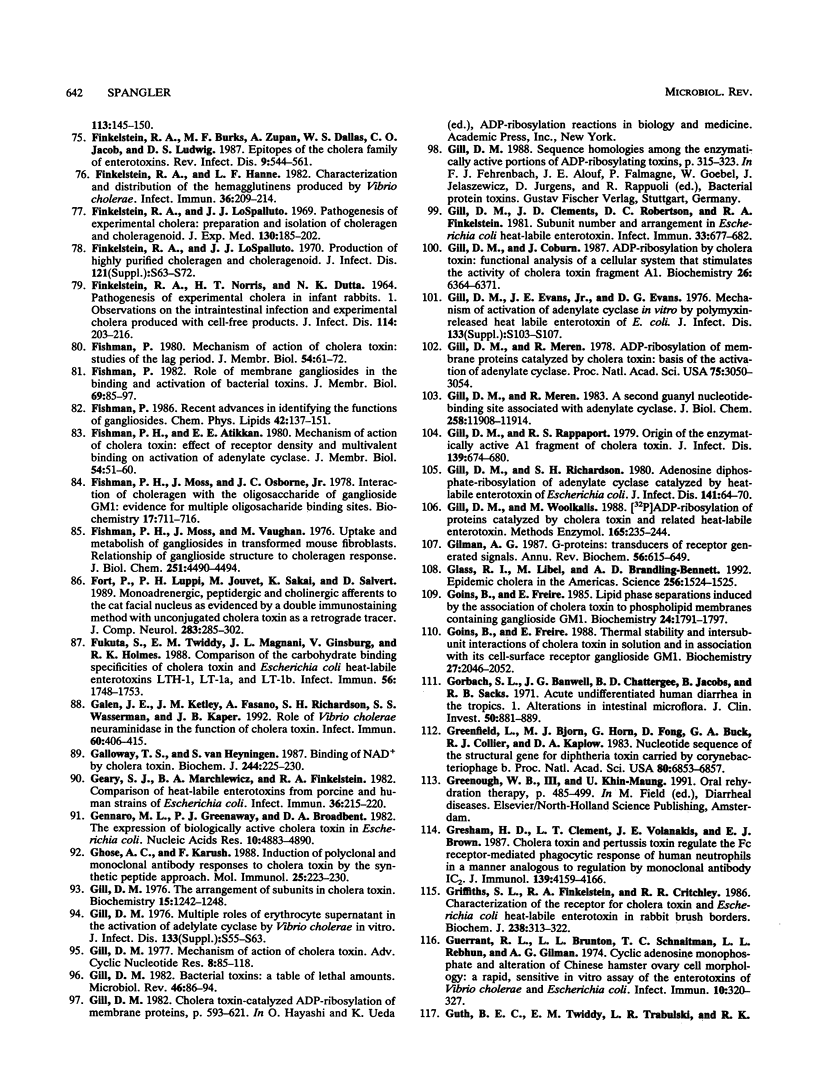
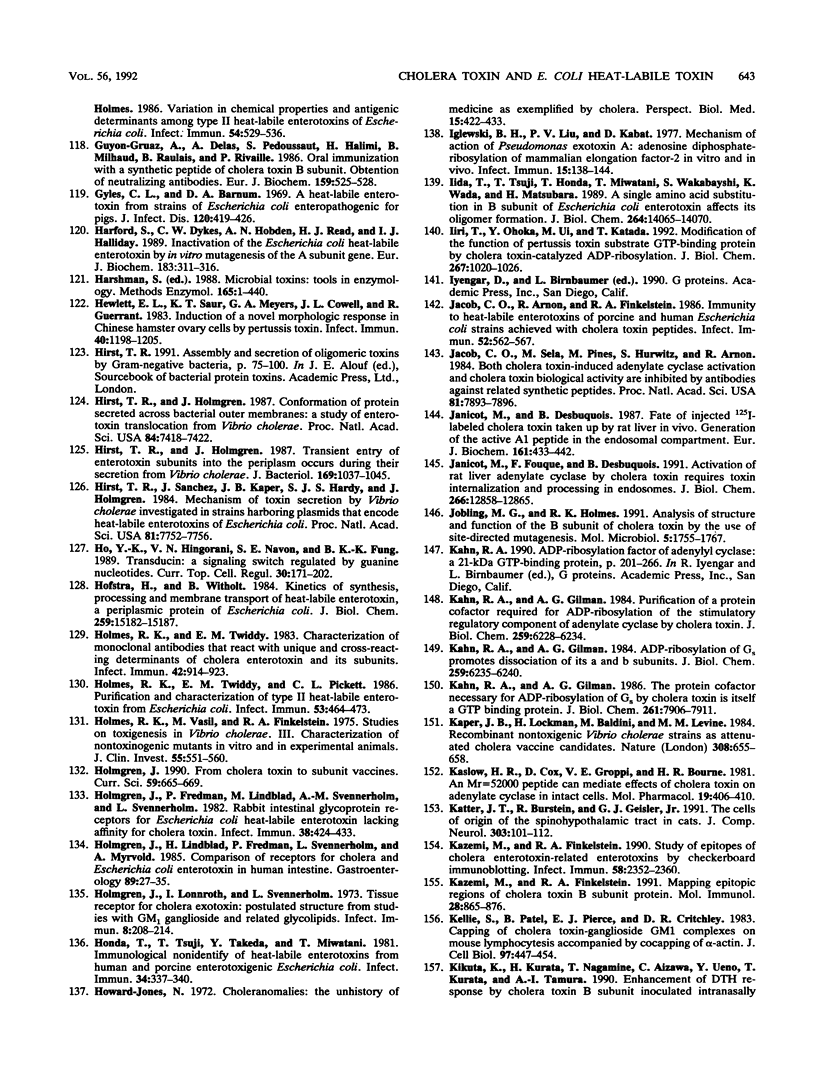
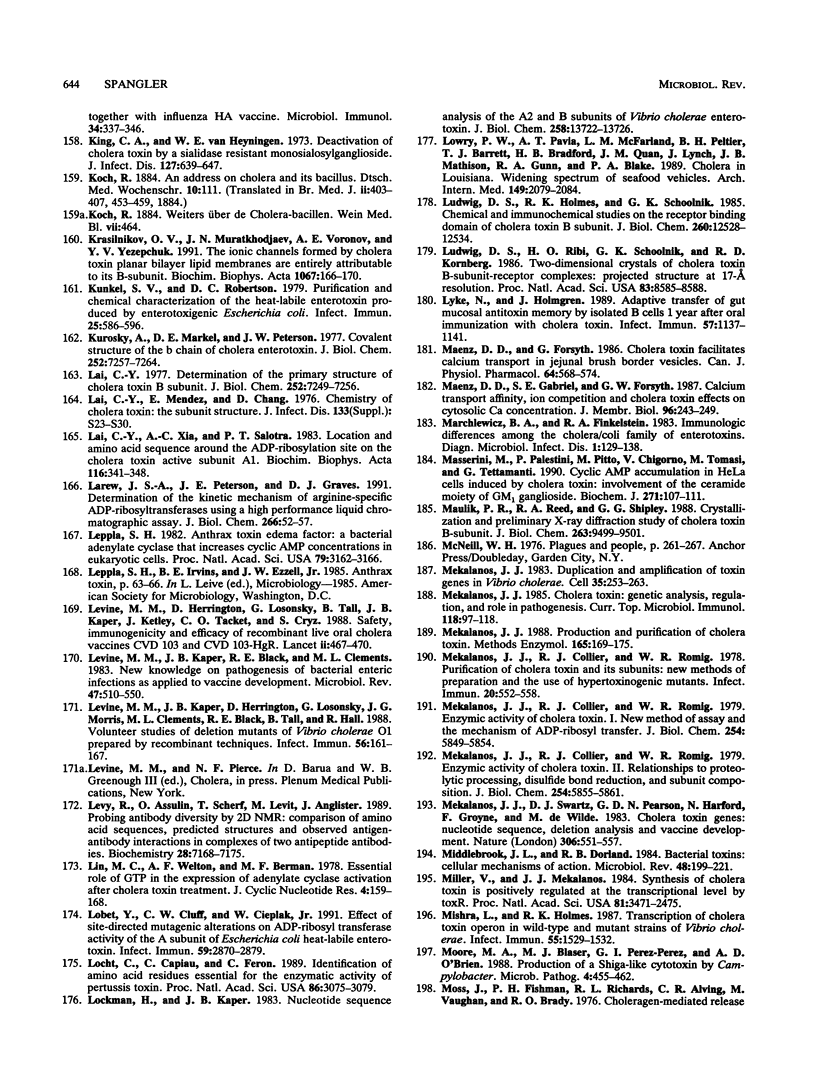
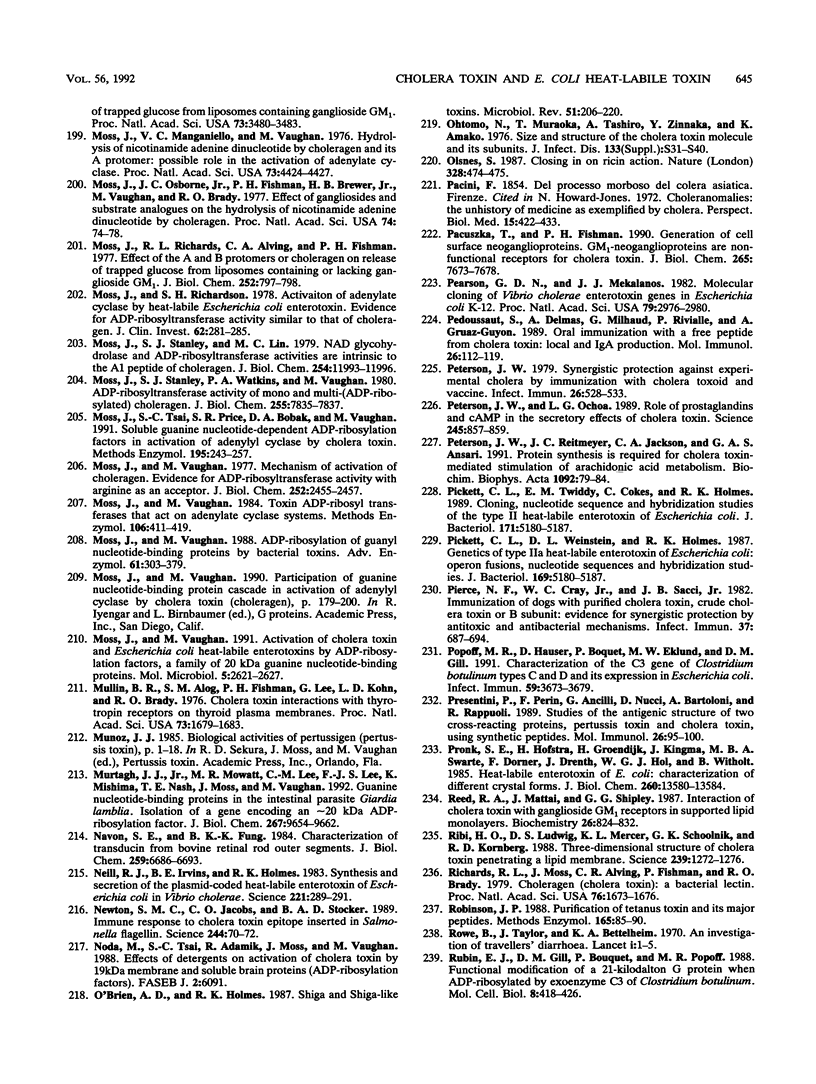

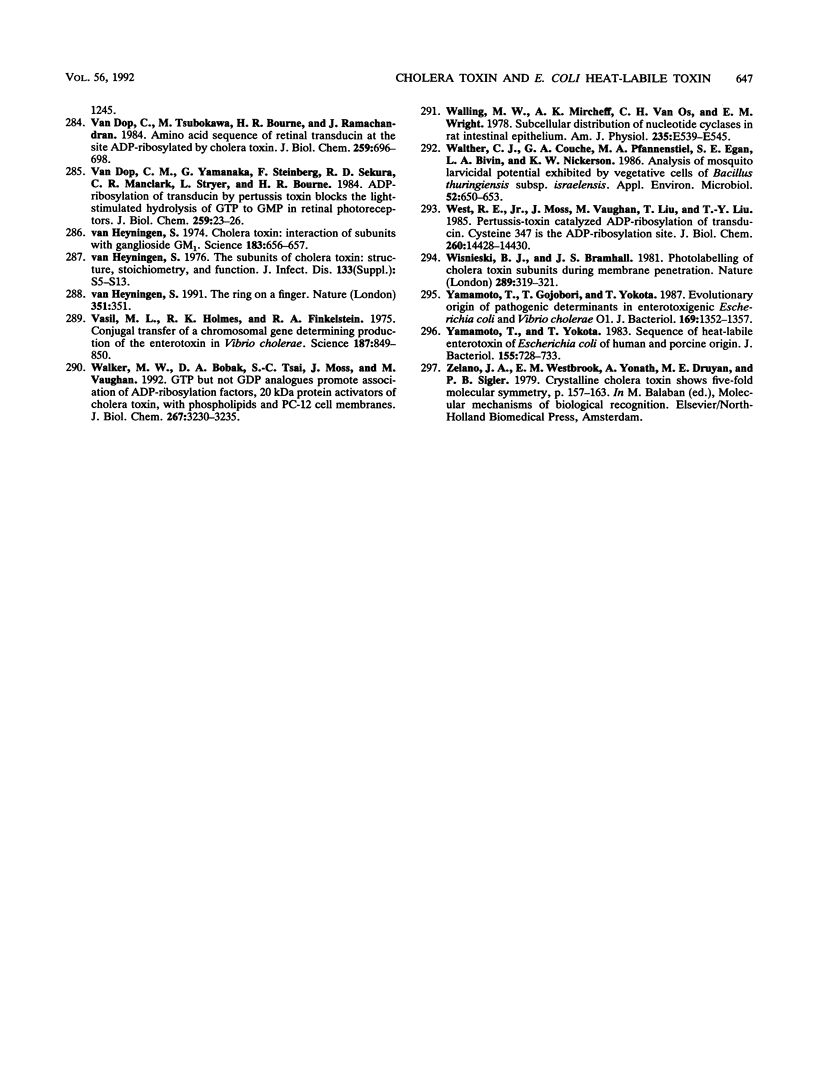
Images in this article
Selected References
These references are in PubMed. This may not be the complete list of references from this article.
- Abood M. E., Hurley J. B., Pappone M. C., Bourne H. R., Stryer L. Functional homology between signal-coupling proteins. Cholera toxin inactivates the GTPase activity of transducin. J Biol Chem. 1982 Sep 25;257(18):10540–10543. [PubMed] [Google Scholar]
- Ackerman G. A., Wolken K. W., Gelder F. B. Differential expression of surface monosialoganglioside GM1 in various hemic cell lines of normal human bone marrow. A quantitative immunocytochemical study using the cholera toxin-gold-labeled anti-cholera toxin procedure. J Histochem Cytochem. 1980 Dec;28(12):1334–1342. doi: 10.1177/28.12.7014713. [DOI] [PubMed] [Google Scholar]
- Aktories K., Bärmann M., Ohishi I., Tsuyama S., Jakobs K. H., Habermann E. Botulinum C2 toxin ADP-ribosylates actin. Nature. 1986 Jul 24;322(6077):390–392. doi: 10.1038/322390a0. [DOI] [PubMed] [Google Scholar]
- Aktories K., Weller U., Chhatwal G. S. Clostridium botulinum type C produces a novel ADP-ribosyltransferase distinct from botulinum C2 toxin. FEBS Lett. 1987 Feb 9;212(1):109–113. doi: 10.1016/0014-5793(87)81566-1. [DOI] [PubMed] [Google Scholar]
- Allured V. S., Collier R. J., Carroll S. F., McKay D. B. Structure of exotoxin A of Pseudomonas aeruginosa at 3.0-Angstrom resolution. Proc Natl Acad Sci U S A. 1986 Mar;83(5):1320–1324. doi: 10.1073/pnas.83.5.1320. [DOI] [PMC free article] [PubMed] [Google Scholar]
- Anderson D. L., Tsoukas C. D. Cholera toxin inhibits resting human T cell activation via a cAMP-independent pathway. J Immunol. 1989 Dec 1;143(11):3647–3652. [PubMed] [Google Scholar]
- Anglister J., Jacob C., Assulin O., Ast G., Pinker R., Arnon R. NMR study of the complexes between a synthetic peptide derived from the B subunit of cholera toxin and three monoclonal antibodies against it. Biochemistry. 1988 Jan 26;27(2):717–724. doi: 10.1021/bi00402a034. [DOI] [PubMed] [Google Scholar]
- Anglister J., Zilber B. Antibodies against a peptide of cholera toxin differing in cross-reactivity with the toxin differ in their specific interactions with the peptide as observed by 1H NMR spectroscopy. Biochemistry. 1990 Jan 30;29(4):921–928. doi: 10.1021/bi00456a011. [DOI] [PubMed] [Google Scholar]
- Aronson A. I., Beckman W., Dunn P. Bacillus thuringiensis and related insect pathogens. Microbiol Rev. 1986 Mar;50(1):1–24. doi: 10.1128/mr.50.1.1-24.1986. [DOI] [PMC free article] [PubMed] [Google Scholar]
- Behzadi G., Kalén P., Parvopassu F., Wiklund L. Afferents to the median raphe nucleus of the rat: retrograde cholera toxin and wheat germ conjugated horseradish peroxidase tracing, and selective D-[3H]aspartate labelling of possible excitatory amino acid inputs. Neuroscience. 1990;37(1):77–100. doi: 10.1016/0306-4522(90)90194-9. [DOI] [PubMed] [Google Scholar]
- Belisle B. W., Twiddy E. M., Holmes R. K. Monoclonal antibodies with an expanded repertoire of specificities and potent neutralizing activity for Escherichia coli heat-labile enterotoxin. Infect Immun. 1984 Dec;46(3):759–764. doi: 10.1128/iai.46.3.759-764.1984. [DOI] [PMC free article] [PubMed] [Google Scholar]
- Bhakuni V., Xie D., Freire E. Thermodynamic identification of stable folding intermediates in the B-subunit of cholera toxin. Biochemistry. 1991 May 21;30(20):5055–5060. doi: 10.1021/bi00234a031. [DOI] [PubMed] [Google Scholar]
- Bittner M. A., DasGupta B. R., Holz R. W. Isolated light chains of botulinum neurotoxins inhibit exocytosis. Studies in digitonin-permeabilized chromaffin cells. J Biol Chem. 1989 Jun 25;264(18):10354–10360. [PubMed] [Google Scholar]
- Black R. E., Levine M. M., Clements M. L., Young C. R., Svennerholm A. M., Holmgren J. Protective efficacy in humans of killed whole-vibrio oral cholera vaccine with and without the B subunit of cholera toxin. Infect Immun. 1987 May;55(5):1116–1120. doi: 10.1128/iai.55.5.1116-1120.1987. [DOI] [PMC free article] [PubMed] [Google Scholar]
- Bobak D. A., Bliziotes M. M., Noda M., Tsai S. C., Adamik R., Moss J. Mechanism of activation of cholera toxin by ADP-ribosylation factor (ARF): both low- and high-affinity interactions of ARF with guanine nucleotides promote toxin activation. Biochemistry. 1990 Jan 30;29(4):855–861. doi: 10.1021/bi00456a600. [DOI] [PubMed] [Google Scholar]
- Booth B. A., Boesman-Finkelstein M., Finkelstein R. A. Vibrio cholerae hemagglutinin/protease nicks cholera enterotoxin. Infect Immun. 1984 Sep;45(3):558–560. doi: 10.1128/iai.45.3.558-560.1984. [DOI] [PMC free article] [PubMed] [Google Scholar]
- Bornside G. H. Jaime Ferran and preventive inoculation against cholera. Bull Hist Med. 1981 Winter;55(4):516–532. [PubMed] [Google Scholar]
- Brandhuber B. J., Allured V. S., Falbel T. G., McKay D. B. Mapping the enzymatic active site of Pseudomonas aeruginosa exotoxin A. Proteins. 1988;3(3):146–154. doi: 10.1002/prot.340030303. [DOI] [PubMed] [Google Scholar]
- Burnette W. N., Cieplak W., Mar V. L., Kaljot K. T., Sato H., Keith J. M. Pertussis toxin S1 mutant with reduced enzyme activity and a conserved protective epitope. Science. 1988 Oct 7;242(4875):72–74. doi: 10.1126/science.2459776. [DOI] [PubMed] [Google Scholar]
- Burnette W. N., Mar V. L., Platler B. W., Schlotterbeck J. D., McGinley M. D., Stoney K. S., Rohde M. F., Kaslow H. R. Site-specific mutagenesis of the catalytic subunit of cholera toxin: substituting lysine for arginine 7 causes loss of activity. Infect Immun. 1991 Nov;59(11):4266–4270. doi: 10.1128/iai.59.11.4266-4270.1991. [DOI] [PMC free article] [PubMed] [Google Scholar]
- Burns D. L., Hausman S. Z., Lindner W., Robey F. A., Manclark C. R. Structural characterization of pertussis toxin A subunit. J Biol Chem. 1987 Dec 25;262(36):17677–17682. [PubMed] [Google Scholar]
- Burns D. L., Moss J., Vaughan M. Release of guanyl nucleotides from the regulatory subunit of adenylate cyclase. J Biol Chem. 1983 Jan 25;258(2):1116–1120. [PubMed] [Google Scholar]
- Burstein R., Wang J. L., Elde R. P., Giesler G. J., Jr Neurons in the sacral parasympathetic nucleus that project to the hypothalamus do not also project through the pelvic nerve--a double labeling study combining Fluoro-gold and cholera toxin B in the rat. Brain Res. 1990 Jan 1;506(1):159–165. doi: 10.1016/0006-8993(90)91214-2. [DOI] [PubMed] [Google Scholar]
- Cambron L. D., Leskawa K. C. A sensitive method to quantitate gangliosides of the gangliotetraose series directly on chromatograms using peroxidase conjugated cholera toxin. Stain Technol. 1990;65(6):293–297. doi: 10.3109/10520299009105620. [DOI] [PubMed] [Google Scholar]
- Carroll S. F., Barbieri J. T., Collier R. J. Diphtheria toxin: purification and properties. Methods Enzymol. 1988;165:68–76. doi: 10.1016/s0076-6879(88)65014-2. [DOI] [PubMed] [Google Scholar]
- Carroll S. F., Collier R. J. Active site of Pseudomonas aeruginosa exotoxin A. Glutamic acid 553 is photolabeled by NAD and shows functional homology with glutamic acid 148 of diphtheria toxin. J Biol Chem. 1987 Jun 25;262(18):8707–8711. [PubMed] [Google Scholar]
- Cassel D., Pfeuffer T. Mechanism of cholera toxin action: covalent modification of the guanyl nucleotide-binding protein of the adenylate cyclase system. Proc Natl Acad Sci U S A. 1978 Jun;75(6):2669–2673. doi: 10.1073/pnas.75.6.2669. [DOI] [PMC free article] [PubMed] [Google Scholar]
- Cassel D., Selinger Z. Mechanism of adenylate cyclase activation by cholera toxin: inhibition of GTP hydrolysis at the regulatory site. Proc Natl Acad Sci U S A. 1977 Aug;74(8):3307–3311. doi: 10.1073/pnas.74.8.3307. [DOI] [PMC free article] [PubMed] [Google Scholar]
- Choe S., Bennett M. J., Fujii G., Curmi P. M., Kantardjieff K. A., Collier R. J., Eisenberg D. The crystal structure of diphtheria toxin. Nature. 1992 May 21;357(6375):216–222. doi: 10.1038/357216a0. [DOI] [PubMed] [Google Scholar]
- Cieplak W., Burnette W. N., Mar V. L., Kaljot K. T., Morris C. F., Chen K. K., Sato H., Keith J. M. Identification of a region in the S1 subunit of pertussis toxin that is required for enzymatic activity and that contributes to the formation of a neutralizing antigenic determinant. Proc Natl Acad Sci U S A. 1988 Jul;85(13):4667–4671. doi: 10.1073/pnas.85.13.4667. [DOI] [PMC free article] [PubMed] [Google Scholar]
- Clemens J. D., Sack D. A., Harris J. R., Chakraborty J., Khan M. R., Stanton B. F., Kay B. A., Khan M. U., Yunus M., Atkinson W. Field trial of oral cholera vaccines in Bangladesh. Lancet. 1986 Jul 19;2(8499):124–127. doi: 10.1016/s0140-6736(86)91944-6. [DOI] [PubMed] [Google Scholar]
- Clemens J. D., Sack D. A., Harris J. R., Chakraborty J., Neogy P. K., Stanton B., Huda N., Khan M. U., Kay B. A., Khan M. R. Cross-protection by B subunit-whole cell cholera vaccine against diarrhea associated with heat-labile toxin-producing enterotoxigenic Escherichia coli: results of a large-scale field trial. J Infect Dis. 1988 Aug;158(2):372–377. doi: 10.1093/infdis/158.2.372. [DOI] [PubMed] [Google Scholar]
- Clemens J. D., Sack D. A., Harris J. R., Van Loon F., Chakraborty J., Ahmed F., Rao M. R., Khan M. R., Yunus M., Huda N. Field trial of oral cholera vaccines in Bangladesh: results from three-year follow-up. Lancet. 1990 Feb 3;335(8684):270–273. doi: 10.1016/0140-6736(90)90080-o. [DOI] [PubMed] [Google Scholar]
- Clements J. D., Yancey R. J., Finkelstein R. A. Properties of homogeneous heat-labile enterotoxin from Escherichia coli. Infect Immun. 1980 Jul;29(1):91–97. doi: 10.1128/iai.29.1.91-97.1980. [DOI] [PMC free article] [PubMed] [Google Scholar]
- Coulson C. J., Nassau P. M., Tait R. M. The ADP-ribosyltransferase activity of cholera toxin and Escherichia coli heat-labile toxin. Biochem Soc Trans. 1984 Apr;12(2):184–187. doi: 10.1042/bst0120184. [DOI] [PubMed] [Google Scholar]
- Craig J. P. A permeability factor (toxin) found in cholera stools and culture filtrates and its neutralization by convalescent cholera sera. Nature. 1965 Aug 7;207(997):614–616. doi: 10.1038/207614a0. [DOI] [PubMed] [Google Scholar]
- Craig S. W., Cuatrecasas P. Mobility of cholera toxin receptors on rat lymphocyte membranes. Proc Natl Acad Sci U S A. 1975 Oct;72(10):3844–3848. doi: 10.1073/pnas.72.10.3844. [DOI] [PMC free article] [PubMed] [Google Scholar]
- Cuatrecasas P. Gangliosides and membrane receptors for cholera toxin. Biochemistry. 1973 Aug 28;12(18):3558–3566. doi: 10.1021/bi00742a032. [DOI] [PubMed] [Google Scholar]
- Cuatrecasas P. Interaction of Vibrio cholerae enterotoxin with cell membranes. Biochemistry. 1973 Aug 28;12(18):3547–3558. doi: 10.1021/bi00742a031. [DOI] [PubMed] [Google Scholar]
- Czerkinsky C., Russell M. W., Lycke N., Lindblad M., Holmgren J. Oral administration of a streptococcal antigen coupled to cholera toxin B subunit evokes strong antibody responses in salivary glands and extramucosal tissues. Infect Immun. 1989 Apr;57(4):1072–1077. doi: 10.1128/iai.57.4.1072-1077.1989. [DOI] [PMC free article] [PubMed] [Google Scholar]
- DE S. N. Enterotoxicity of bacteria-free culture-filtrate of Vibrio cholerae. Nature. 1959 May 30;183(4674):1533–1534. doi: 10.1038/1831533a0. [DOI] [PubMed] [Google Scholar]
- DUTTA N. K., PANSE M. V., KULKARNI D. R. Role of cholera a toxin in experimental cholera. J Bacteriol. 1959 Oct;78:594–595. doi: 10.1128/jb.78.4.594-595.1959. [DOI] [PMC free article] [PubMed] [Google Scholar]
- Dallas W. S., Falkow S. Amino acid sequence homology between cholera toxin and Escherichia coli heat-labile toxin. Nature. 1980 Dec 4;288(5790):499–501. doi: 10.1038/288499a0. [DOI] [PubMed] [Google Scholar]
- Dallas W. S., Gill D. M., Falkow S. Cistrons encoding Escherichia coli heat-labile toxin. J Bacteriol. 1979 Sep;139(3):850–858. doi: 10.1128/jb.139.3.850-858.1979. [DOI] [PMC free article] [PubMed] [Google Scholar]
- Dalziel A. W., Lipka G., Chowdhry B. Z., Sturtevant J. M., Schafer D. E. Effects of ganglioside GM1 on the thermotropic behavior of cholera toxin B subunit. Mol Cell Biochem. 1984 Aug;63(1):83–91. doi: 10.1007/BF00230165. [DOI] [PubMed] [Google Scholar]
- Dams E., De Wolf M., Dierick W. Nucleotide sequence analysis of the CT operon of the Vibrio cholerae classical strain 569B. Biochim Biophys Acta. 1991 Aug 27;1090(1):139–141. doi: 10.1016/0167-4781(91)90050-v. [DOI] [PubMed] [Google Scholar]
- De Wolf M. J., Fridkin M., Epstein M., Kohn L. D. Structure-function studies of cholera toxin and its A and B protomers. Modification of tryptophan residues. J Biol Chem. 1981 Jun 10;256(11):5481–5488. [PubMed] [Google Scholar]
- De Wolf M. J., Fridkin M., Kohn L. D. Tryptophan residues of cholera toxin and its A and B protomers. Intrinsic fluorescence and solute quenching upon interacting with the ganglioside GM1, oligo-GM1, or dansylated oligo-GM1. J Biol Chem. 1981 Jun 10;256(11):5489–5496. [PubMed] [Google Scholar]
- De Wolf M. J., Van Dessel G. A., Lagrou A. R., Hilderson H. J., Dierick W. S. pH-induced transitions in cholera toxin conformation: a fluorescence study. Biochemistry. 1987 Jun 30;26(13):3799–3806. doi: 10.1021/bi00387a010. [DOI] [PubMed] [Google Scholar]
- Delmas A., Gruaz-Guyon A., Pedoussaut S., Pierre P., Rivaille P., Vaerman J. P. Neutralization of cholera toxin by rat IgA secretory antibodies induced by a free synthetic peptide. Biochem Biophys Res Commun. 1989 Mar 15;159(2):707–712. doi: 10.1016/0006-291x(89)90052-1. [DOI] [PubMed] [Google Scholar]
- DiRita V. J., Parsot C., Jander G., Mekalanos J. J. Regulatory cascade controls virulence in Vibrio cholerae. Proc Natl Acad Sci U S A. 1991 Jun 15;88(12):5403–5407. doi: 10.1073/pnas.88.12.5403. [DOI] [PMC free article] [PubMed] [Google Scholar]
- Dixon S. J., Stewart D., Grinstein S., Spiegel S. Transmembrane signaling by the B subunit of cholera toxin: increased cytoplasmic free calcium in rat lymphocytes. J Cell Biol. 1987 Sep;105(3):1153–1161. doi: 10.1083/jcb.105.3.1153. [DOI] [PMC free article] [PubMed] [Google Scholar]
- Domenighini M., Montecucco C., Ripka W. C., Rappuoli R. Computer modelling of the NAD binding site of ADP-ribosylating toxins: active-site structure and mechanism of NAD binding. Mol Microbiol. 1991 Jan;5(1):23–31. doi: 10.1111/j.1365-2958.1991.tb01822.x. [DOI] [PubMed] [Google Scholar]
- Domínguez P., Velasco G., Barros F., Lazo P. S. Intestinal brush border membranes contain regulatory subunits of adenylyl cyclase. Proc Natl Acad Sci U S A. 1987 Oct;84(20):6965–6969. doi: 10.1073/pnas.84.20.6965. [DOI] [PMC free article] [PubMed] [Google Scholar]
- Donta S. T., Damiano-Burbach P., Poindexter N. J. Modulation of enterotoxin binding and function in vitro and in vivo. J Infect Dis. 1988 Mar;157(3):557–564. doi: 10.1093/infdis/157.3.557. [DOI] [PubMed] [Google Scholar]
- Douglas C. M., Collier R. J. Exotoxin A of Pseudomonas aeruginosa: substitution of glutamic acid 553 with aspartic acid drastically reduces toxicity and enzymatic activity. J Bacteriol. 1987 Nov;169(11):4967–4971. doi: 10.1128/jb.169.11.4967-4971.1987. [DOI] [PMC free article] [PubMed] [Google Scholar]
- Dwyer J. D., Bloomfield V. A. Cholera toxin mediated agglutination of ganglioside Gm1 containing phospholipid vesicles and Gm1-coated polystyrene spheres. Biochemistry. 1982 Jun 22;21(13):3231–3234. doi: 10.1021/bi00256a031. [DOI] [PubMed] [Google Scholar]
- Dwyer J. D., Bloomfield V. A. Subunit arrangement of cholera toxin in solution and bound to receptor-containing model membranes. Biochemistry. 1982 Jun 22;21(13):3227–3231. doi: 10.1021/bi00256a030. [DOI] [PubMed] [Google Scholar]
- Endo Y., Tsurugi K. RNA N-glycosidase activity of ricin A-chain. Mechanism of action of the toxic lectin ricin on eukaryotic ribosomes. J Biol Chem. 1987 Jun 15;262(17):8128–8130. [PubMed] [Google Scholar]
- Endo Y., Tsurugi K., Yutsudo T., Takeda Y., Ogasawara T., Igarashi K. Site of action of a Vero toxin (VT2) from Escherichia coli O157:H7 and of Shiga toxin on eukaryotic ribosomes. RNA N-glycosidase activity of the toxins. Eur J Biochem. 1988 Jan 15;171(1-2):45–50. doi: 10.1111/j.1432-1033.1988.tb13756.x. [DOI] [PubMed] [Google Scholar]
- Enomoto K., Gill D. M. Cholera toxin activation of adenylate cyclase. Roles of nucleoside triphosphates and a macromolecular factor in the ADP ribosylation of the GTP-dependent regulatory component. J Biol Chem. 1980 Feb 25;255(4):1252–1258. [PubMed] [Google Scholar]
- Ericson H., Blomqvist A. Tracing of neuronal connections with cholera toxin subunit B: light and electron microscopic immunohistochemistry using monoclonal antibodies. J Neurosci Methods. 1988 Jul;24(3):225–235. doi: 10.1016/0165-0270(88)90167-7. [DOI] [PubMed] [Google Scholar]
- FINKELSTEIN R. A., NORRIS H. T., DUTTA N. K. PATHOGENESIS EXPERIMENTAL CHOLERA IN INFANT RABBITS. I. OBSERVATIONS ON THE INTRAINTESTINAL INFECTION AND EXPERIMENTAL CHOLERA PRODUCED WITH CELL-FREE PRODUCTS. J Infect Dis. 1964 Jun;114:203–216. doi: 10.1093/infdis/114.3.203. [DOI] [PubMed] [Google Scholar]
- Fasano A., Baudry B., Pumplin D. W., Wasserman S. S., Tall B. D., Ketley J. M., Kaper J. B. Vibrio cholerae produces a second enterotoxin, which affects intestinal tight junctions. Proc Natl Acad Sci U S A. 1991 Jun 15;88(12):5242–5246. doi: 10.1073/pnas.88.12.5242. [DOI] [PMC free article] [PubMed] [Google Scholar]
- Field M., Rao M. C., Chang E. B. Intestinal electrolyte transport and diarrheal disease (1). N Engl J Med. 1989 Sep 21;321(12):800–806. doi: 10.1056/NEJM198909213211206. [DOI] [PubMed] [Google Scholar]
- Field M., Rao M. C., Chang E. B. Intestinal electrolyte transport and diarrheal disease (2) N Engl J Med. 1989 Sep 28;321(13):879–883. doi: 10.1056/NEJM198909283211307. [DOI] [PubMed] [Google Scholar]
- Finkelstein R. A., Burks M. F., Zupan A., Dallas W. S., Jacob C. O., Ludwig D. S. Epitopes of the cholera family of enterotoxins. Rev Infect Dis. 1987 May-Jun;9(3):544–561. doi: 10.1093/clinids/9.3.544. [DOI] [PubMed] [Google Scholar]
- Finkelstein R. A., LoSpalluto J. J. Pathogenesis of experimental cholera. Preparation and isolation of choleragen and choleragenoid. J Exp Med. 1969 Jul 1;130(1):185–202. doi: 10.1084/jem.130.1.185. [DOI] [PMC free article] [PubMed] [Google Scholar]
- Fishman P. H., Atikkan E. E. Mechanism of action of cholera toxin: effect of receptor density and multivalent binding on activation of adenylate cyclase. J Membr Biol. 1980;54(1):51–60. doi: 10.1007/BF01875376. [DOI] [PubMed] [Google Scholar]
- Fishman P. H. Mechanism of action of cholera toxin: studies on the lag period. J Membr Biol. 1980;54(1):61–72. doi: 10.1007/BF01875377. [DOI] [PubMed] [Google Scholar]
- Fishman P. H., Moss J., Osborne J. C., Jr Interaction of choleragen with the oligosaccharide of ganglioside GM1: evidence for multiple oligosaccharide binding sites. Biochemistry. 1978 Feb 21;17(4):711–716. doi: 10.1021/bi00597a024. [DOI] [PubMed] [Google Scholar]
- Fishman P. H., Moss J., Vaughan M. Uptake and metabolism of gangliosides in transformed mouse fibroblasts. Relationship of ganglioside structure to choleragen response. J Biol Chem. 1976 Aug 10;251(15):4490–4494. [PubMed] [Google Scholar]
- Fishman P. H. Recent advances in identifying the functions of gangliosides. Chem Phys Lipids. 1986 Dec 15;42(1-3):137–151. doi: 10.1016/0009-3084(86)90049-6. [DOI] [PubMed] [Google Scholar]
- Fishman P. H. Role of membrane gangliosides in the binding and action of bacterial toxins. J Membr Biol. 1982;69(2):85–97. doi: 10.1007/BF01872268. [DOI] [PubMed] [Google Scholar]
- Fort P., Sakai K., Luppi P. H., Salvert D., Jouvet M. Monoaminergic, peptidergic, and cholinergic afferents to the cat facial nucleus as evidenced by a double immunostaining method with unconjugated cholera toxin as a retrograde tracer. J Comp Neurol. 1989 May 8;283(2):285–302. doi: 10.1002/cne.902830209. [DOI] [PubMed] [Google Scholar]
- Fukuta S., Magnani J. L., Twiddy E. M., Holmes R. K., Ginsburg V. Comparison of the carbohydrate-binding specificities of cholera toxin and Escherichia coli heat-labile enterotoxins LTh-I, LT-IIa, and LT-IIb. Infect Immun. 1988 Jul;56(7):1748–1753. doi: 10.1128/iai.56.7.1748-1753.1988. [DOI] [PMC free article] [PubMed] [Google Scholar]
- Galen J. E., Ketley J. M., Fasano A., Richardson S. H., Wasserman S. S., Kaper J. B. Role of Vibrio cholerae neuraminidase in the function of cholera toxin. Infect Immun. 1992 Feb;60(2):406–415. doi: 10.1128/iai.60.2.406-415.1992. [DOI] [PMC free article] [PubMed] [Google Scholar]
- Galloway T. S., van Heyningen S. Binding of NAD+ by cholera toxin. Biochem J. 1987 May 15;244(1):225–230. doi: 10.1042/bj2440225. [DOI] [PMC free article] [PubMed] [Google Scholar]
- Geary S. J., Marchlewicz B. A., Finkelstein R. A. Comparison of heat-labile enterotoxins from porcine and human strains of Escherichia coli. Infect Immun. 1982 Apr;36(1):215–220. doi: 10.1128/iai.36.1.215-220.1982. [DOI] [PMC free article] [PubMed] [Google Scholar]
- Gennaro M. L., Greenaway P. J., Broadbent D. A. The expression of biologically active cholera toxin in Escherichia coli. Nucleic Acids Res. 1982 Aug 25;10(16):4883–4890. doi: 10.1093/nar/10.16.4883. [DOI] [PMC free article] [PubMed] [Google Scholar]
- Ghose A. C., Karush F. Induction of polyclonal and monoclonal antibody responses to cholera toxin by the synthetic peptide approach. Mol Immunol. 1988 Mar;25(3):223–230. doi: 10.1016/0161-5890(88)90013-2. [DOI] [PubMed] [Google Scholar]
- Gill D. M. Bacterial toxins: a table of lethal amounts. Microbiol Rev. 1982 Mar;46(1):86–94. doi: 10.1128/mr.46.1.86-94.1982. [DOI] [PMC free article] [PubMed] [Google Scholar]
- Gill D. M., Clements J. D., Robertson D. C., Finkelstein R. A. Subunit number and arrangement in Escherichia coli heat-labile enterotoxin. Infect Immun. 1981 Sep;33(3):677–682. doi: 10.1128/iai.33.3.677-682.1981. [DOI] [PMC free article] [PubMed] [Google Scholar]
- Gill D. M., Coburn J. ADP-ribosylation by cholera toxin: functional analysis of a cellular system that stimulates the enzymic activity of cholera toxin fragment A1. Biochemistry. 1987 Oct 6;26(20):6364–6371. doi: 10.1021/bi00394a009. [DOI] [PubMed] [Google Scholar]
- Gill D. M. Mechanism of action of cholera toxin. Adv Cyclic Nucleotide Res. 1977;8:85–118. [PubMed] [Google Scholar]
- Gill D. M., Meren R. A second guanyl nucleotide-binding site associated with adenylate cyclase. Distinct nucleotides activate adenylate cyclase and permit ADP-ribosylation by cholera toxin. J Biol Chem. 1983 Oct 10;258(19):11908–11914. [PubMed] [Google Scholar]
- Gill D. M., Meren R. ADP-ribosylation of membrane proteins catalyzed by cholera toxin: basis of the activation of adenylate cyclase. Proc Natl Acad Sci U S A. 1978 Jul;75(7):3050–3054. doi: 10.1073/pnas.75.7.3050. [DOI] [PMC free article] [PubMed] [Google Scholar]
- Gill D. M. Multiple roles of erythrocyte supernatant in the activation of adenylate cyclase by Vibrio cholerae toxin in vitro. J Infect Dis. 1976 Mar;133 (Suppl):55–63. doi: 10.1093/infdis/133.supplement_1.s55. [DOI] [PubMed] [Google Scholar]
- Gill D. M., Rappaport R. S. Origin of the enzymatically active A1 fragment of cholera toxin. J Infect Dis. 1979 Jun;139(6):674–680. doi: 10.1093/infdis/139.6.674. [DOI] [PubMed] [Google Scholar]
- Gill D. M., Richardson S. H. Adenosine diphosphate-ribosylation of adenylate cyclase catalyzed by heat-labile enterotoxin of Escherichia coli: comparison with cholera toxin. J Infect Dis. 1980 Jan;141(1):64–70. doi: 10.1093/infdis/141.1.64. [DOI] [PubMed] [Google Scholar]
- Gill D. M. The arrangement of subunits in cholera toxin. Biochemistry. 1976 Mar 23;15(6):1242–1248. doi: 10.1021/bi00651a011. [DOI] [PubMed] [Google Scholar]
- Gill D. M., Woolkalis M. [32P]ADP-ribosylation of proteins catalyzed by cholera toxin and related heat-labile enterotoxins. Methods Enzymol. 1988;165:235–245. doi: 10.1016/s0076-6879(88)65037-3. [DOI] [PubMed] [Google Scholar]
- Gilman A. G. G proteins: transducers of receptor-generated signals. Annu Rev Biochem. 1987;56:615–649. doi: 10.1146/annurev.bi.56.070187.003151. [DOI] [PubMed] [Google Scholar]
- Glass R. I., Libel M., Brandling-Bennett A. D. Epidemic cholera in the Americas. Science. 1992 Jun 12;256(5063):1524–1525. doi: 10.1126/science.1598586. [DOI] [PubMed] [Google Scholar]
- Goins B., Freire E. Lipid phase separations induced by the association of cholera toxin to phospholipid membranes containing ganglioside GM1. Biochemistry. 1985 Mar 26;24(7):1791–1797. doi: 10.1021/bi00328a033. [DOI] [PubMed] [Google Scholar]
- Goins B., Freire E. Thermal stability and intersubunit interactions of cholera toxin in solution and in association with its cell-surface receptor ganglioside GM1. Biochemistry. 1988 Mar 22;27(6):2046–2052. doi: 10.1021/bi00406a035. [DOI] [PubMed] [Google Scholar]
- Gorbach S. L., Banwell J. G., Chatterjee B. D., Jacobs B., Sack R. B. Acute undifferentiated human diarrhea in the tropics. I. Alterations in intestinal micrflora. J Clin Invest. 1971 Apr;50(4):881–889. doi: 10.1172/JCI106560. [DOI] [PMC free article] [PubMed] [Google Scholar]
- Greenfield L., Bjorn M. J., Horn G., Fong D., Buck G. A., Collier R. J., Kaplan D. A. Nucleotide sequence of the structural gene for diphtheria toxin carried by corynebacteriophage beta. Proc Natl Acad Sci U S A. 1983 Nov;80(22):6853–6857. doi: 10.1073/pnas.80.22.6853. [DOI] [PMC free article] [PubMed] [Google Scholar]
- Gresham H. D., Clement L. T., Volanakis J. E., Brown E. J. Cholera toxin and pertussis toxin regulate the Fc receptor-mediated phagocytic response of human neutrophils in a manner analogous to regulation by monoclonal antibody 1C2. J Immunol. 1987 Dec 15;139(12):4159–4166. [PubMed] [Google Scholar]
- Griffiths S. L., Finkelstein R. A., Critchley D. R. Characterization of the receptor for cholera toxin and Escherichia coli heat-labile toxin in rabbit intestinal brush borders. Biochem J. 1986 Sep 1;238(2):313–322. doi: 10.1042/bj2380313. [DOI] [PMC free article] [PubMed] [Google Scholar]
- Guerrant R. L., Brunton L. L., Schnaitman T. C., Rebhun L. I., Gilman A. G. Cyclic adenosine monophosphate and alteration of Chinese hamster ovary cell morphology: a rapid, sensitive in vitro assay for the enterotoxins of Vibrio cholerae and Escherichia coli. Infect Immun. 1974 Aug;10(2):320–327. doi: 10.1128/iai.10.2.320-327.1974. [DOI] [PMC free article] [PubMed] [Google Scholar]
- Guth B. E., Twiddy E. M., Trabulsi L. R., Holmes R. K. Variation in chemical properties and antigenic determinants among type II heat-labile enterotoxins of Escherichia coli. Infect Immun. 1986 Nov;54(2):529–536. doi: 10.1128/iai.54.2.529-536.1986. [DOI] [PMC free article] [PubMed] [Google Scholar]
- Guyon-Gruaz A., Delmas A., Pedoussaut S., Halimi H., Milhaud G., Raulais D., Rivaille P. Oral immunization with a synthetic peptide of cholera toxin B subunit. Obtention of neutralizing antibodies. Eur J Biochem. 1986 Sep 15;159(3):525–528. doi: 10.1111/j.1432-1033.1986.tb09918.x. [DOI] [PubMed] [Google Scholar]
- Gyles C. L., Barnum D. A. A heat-labile enterotoxin from strains of Eschericha coli enteropathogenic for pigs. J Infect Dis. 1969 Oct;120(4):419–426. doi: 10.1093/infdis/120.4.419. [DOI] [PubMed] [Google Scholar]
- Hanne L. F., Finkelstein R. A. Characterization and distribution of the hemagglutinins produced by Vibrio cholerae. Infect Immun. 1982 Apr;36(1):209–214. doi: 10.1128/iai.36.1.209-214.1982. [DOI] [PMC free article] [PubMed] [Google Scholar]
- Harford S., Dykes C. W., Hobden A. N., Read M. J., Halliday I. J. Inactivation of the Escherichia coli heat-labile enterotoxin by in vitro mutagenesis of the A-subunit gene. Eur J Biochem. 1989 Aug 1;183(2):311–316. doi: 10.1111/j.1432-1033.1989.tb14930.x. [DOI] [PubMed] [Google Scholar]
- Hewlett E. L., Sauer K. T., Myers G. A., Cowell J. L., Guerrant R. L. Induction of a novel morphological response in Chinese hamster ovary cells by pertussis toxin. Infect Immun. 1983 Jun;40(3):1198–1203. doi: 10.1128/iai.40.3.1198-1203.1983. [DOI] [PMC free article] [PubMed] [Google Scholar]
- Heyningen S Van Cholera toxin: interaction of subunits with ganglioside GM1. Science. 1974 Feb 15;183(4125):656–657. doi: 10.1126/science.183.4125.656. [DOI] [PubMed] [Google Scholar]
- Hirst T. R., Holmgren J. Conformation of protein secreted across bacterial outer membranes: a study of enterotoxin translocation from Vibrio cholerae. Proc Natl Acad Sci U S A. 1987 Nov;84(21):7418–7422. doi: 10.1073/pnas.84.21.7418. [DOI] [PMC free article] [PubMed] [Google Scholar]
- Hirst T. R., Holmgren J. Transient entry of enterotoxin subunits into the periplasm occurs during their secretion from Vibrio cholerae. J Bacteriol. 1987 Mar;169(3):1037–1045. doi: 10.1128/jb.169.3.1037-1045.1987. [DOI] [PMC free article] [PubMed] [Google Scholar]
- Hirst T. R., Sanchez J., Kaper J. B., Hardy S. J., Holmgren J. Mechanism of toxin secretion by Vibrio cholerae investigated in strains harboring plasmids that encode heat-labile enterotoxins of Escherichia coli. Proc Natl Acad Sci U S A. 1984 Dec;81(24):7752–7756. doi: 10.1073/pnas.81.24.7752. [DOI] [PMC free article] [PubMed] [Google Scholar]
- Ho Y. K., Hingorani V. N., Navon S. E., Fung B. K. Transducin: a signaling switch regulated by guanine nucleotides. Curr Top Cell Regul. 1989;30:171–202. doi: 10.1016/b978-0-12-152830-0.50008-6. [DOI] [PubMed] [Google Scholar]
- Hofstra H., Witholt B. Kinetics of synthesis, processing, and membrane transport of heat-labile enterotoxin, a periplasmic protein in Escherichia coli. J Biol Chem. 1984 Dec 25;259(24):15182–15187. [PubMed] [Google Scholar]
- Holmes R. K., Twiddy E. M. Characterization of monoclonal antibodies that react with unique and cross-reacting determinants of cholera enterotoxin and its subunits. Infect Immun. 1983 Dec;42(3):914–923. doi: 10.1128/iai.42.3.914-923.1983. [DOI] [PMC free article] [PubMed] [Google Scholar]
- Holmes R. K., Twiddy E. M., Pickett C. L. Purification and characterization of type II heat-labile enterotoxin of Escherichia coli. Infect Immun. 1986 Sep;53(3):464–473. doi: 10.1128/iai.53.3.464-473.1986. [DOI] [PMC free article] [PubMed] [Google Scholar]
- Holmes R. K., Vasil M. L., Finkelstein R. A. Studies on toxinogenesis in Vibrio cholerae. III. Characterization of nontoxinogenic mutants in vitro and in experimental animals. J Clin Invest. 1975 Mar;55(3):551–560. doi: 10.1172/JCI107962. [DOI] [PMC free article] [PubMed] [Google Scholar]
- Holmgren J., Fredman P., Lindblad M., Svennerholm A. M., Svennerholm L. Rabbit intestinal glycoprotein receptor for Escherichia coli heat-labile enterotoxin lacking affinity for cholera toxin. Infect Immun. 1982 Nov;38(2):424–433. doi: 10.1128/iai.38.2.424-433.1982. [DOI] [PMC free article] [PubMed] [Google Scholar]
- Holmgren J., Lindblad M., Fredman P., Svennerholm L., Myrvold H. Comparison of receptors for cholera and Escherichia coli enterotoxins in human intestine. Gastroenterology. 1985 Jul;89(1):27–35. doi: 10.1016/0016-5085(85)90741-3. [DOI] [PubMed] [Google Scholar]
- Holmgren J., Lönnroth I., Svennerholm L. Tissue receptor for cholera exotoxin: postulated structure from studies with GM1 ganglioside and related glycolipids. Infect Immun. 1973 Aug;8(2):208–214. doi: 10.1128/iai.8.2.208-214.1973. [DOI] [PMC free article] [PubMed] [Google Scholar]
- Honda T., Tsuji T., Takeda Y., Miwatani T. Immunological nonidentity of heat-labile enterotoxins from human and porcine enterotoxigenic Escherichia coli. Infect Immun. 1981 Nov;34(2):337–340. doi: 10.1128/iai.34.2.337-340.1981. [DOI] [PMC free article] [PubMed] [Google Scholar]
- Howard-Jones N. Choleranomalies: the unhistory of medicine as exemplified by cholera. Perspect Biol Med. 1972 Spring;15(3):422–433. doi: 10.1353/pbm.1972.0044. [DOI] [PubMed] [Google Scholar]
- Howard-Jones N. Choleranomalies: the unhistory of medicine as exemplified by cholera. Perspect Biol Med. 1972 Spring;15(3):422–433. doi: 10.1353/pbm.1972.0044. [DOI] [PubMed] [Google Scholar]
- Iglewski B. H., Liu P. V., Kabat D. Mechanism of action of Pseudomonas aeruginosa exotoxin Aiadenosine diphosphate-ribosylation of mammalian elongation factor 2 in vitro and in vivo. Infect Immun. 1977 Jan;15(1):138–144. doi: 10.1128/iai.15.1.138-144.1977. [DOI] [PMC free article] [PubMed] [Google Scholar]
- Iida T., Tsuji T., Honda T., Miwatani T., Wakabayashi S., Wada K., Matsubara H. A single amino acid substitution in B subunit of Escherichia coli enterotoxin affects its oligomer formation. J Biol Chem. 1989 Aug 25;264(24):14065–14070. [PubMed] [Google Scholar]
- Iiri T., Ohoka Y., Ui M., Katada T. Modification of the function of pertussis toxin substrate GTP-binding protein by cholera toxin-catalyzed ADP-ribosylation. J Biol Chem. 1992 Jan 15;267(2):1020–1026. [PubMed] [Google Scholar]
- Jacob C. O., Arnon R., Finkelstein R. A. Immunity to heat-labile enterotoxins of porcine and human Escherichia coli strains achieved with synthetic cholera toxin peptides. Infect Immun. 1986 May;52(2):562–567. doi: 10.1128/iai.52.2.562-567.1986. [DOI] [PMC free article] [PubMed] [Google Scholar]
- Jacob C. O., Sela M., Pines M., Hurwitz S., Arnon R. Both cholera toxin-induced adenylate cyclase activation and cholera toxin biological activity are inhibited by antibodies against related synthetic peptides. Proc Natl Acad Sci U S A. 1984 Dec;81(24):7893–7896. doi: 10.1073/pnas.81.24.7893. [DOI] [PMC free article] [PubMed] [Google Scholar]
- Janicot M., Desbuquois B. Fate of injected 125I-labeled cholera toxin taken up by rat liver in vivo. Generation of the active A1 peptide in the endosomal compartment. Eur J Biochem. 1987 Mar 2;163(2):433–442. doi: 10.1111/j.1432-1033.1987.tb10816.x. [DOI] [PubMed] [Google Scholar]
- Janicot M., Fouque F., Desbuquois B. Activation of rat liver adenylate cyclase by cholera toxin requires toxin internalization and processing in endosomes. J Biol Chem. 1991 Jul 15;266(20):12858–12865. [PubMed] [Google Scholar]
- Jobling M. G., Holmes R. K. Analysis of structure and function of the B subunit of cholera toxin by the use of site-directed mutagenesis. Mol Microbiol. 1991 Jul;5(7):1755–1767. doi: 10.1111/j.1365-2958.1991.tb01925.x. [DOI] [PubMed] [Google Scholar]
- Kahn R. A., Gilman A. G. ADP-ribosylation of Gs promotes the dissociation of its alpha and beta subunits. J Biol Chem. 1984 May 25;259(10):6235–6240. [PubMed] [Google Scholar]
- Kahn R. A., Gilman A. G. Purification of a protein cofactor required for ADP-ribosylation of the stimulatory regulatory component of adenylate cyclase by cholera toxin. J Biol Chem. 1984 May 25;259(10):6228–6234. [PubMed] [Google Scholar]
- Kahn R. A., Gilman A. G. The protein cofactor necessary for ADP-ribosylation of Gs by cholera toxin is itself a GTP binding protein. J Biol Chem. 1986 Jun 15;261(17):7906–7911. [PubMed] [Google Scholar]
- Kaper J. B., Lockman H., Baldini M. M., Levine M. M. Recombinant nontoxinogenic Vibrio cholerae strains as attenuated cholera vaccine candidates. Nature. 1984 Apr 12;308(5960):655–658. doi: 10.1038/308655a0. [DOI] [PubMed] [Google Scholar]
- Kaslow H. R., Cox D., Groppi V. E., Bourne H. R. An Mr = 52,000 peptide can mediate effects on cholera toxin on adenylate cyclase in intact cells. Mol Pharmacol. 1981 May;19(3):406–410. [PubMed] [Google Scholar]
- Katter J. T., Burstein R., Giesler G. J., Jr The cells of origin of the spinohypothalamic tract in cats. J Comp Neurol. 1991 Jan 1;303(1):101–112. doi: 10.1002/cne.903030109. [DOI] [PubMed] [Google Scholar]
- Kazemi M., Finkelstein R. A. Mapping epitopic regions of cholera toxin B-subunit protein. Mol Immunol. 1991 Aug;28(8):865–876. doi: 10.1016/0161-5890(91)90050-t. [DOI] [PubMed] [Google Scholar]
- Kazemi M., Finkelstein R. A. Study of epitopes of cholera enterotoxin-related enterotoxins by checkerboard immunoblotting. Infect Immun. 1990 Jul;58(7):2352–2360. doi: 10.1128/iai.58.7.2352-2360.1990. [DOI] [PMC free article] [PubMed] [Google Scholar]
- Kellie S., Patel B., Pierce E. J., Critchley D. R. Capping of cholera toxin-ganglioside GM1 complexes on mouse lymphocytes is accompanied by co-capping of alpha-actinin. J Cell Biol. 1983 Aug;97(2):447–454. doi: 10.1083/jcb.97.2.447. [DOI] [PMC free article] [PubMed] [Google Scholar]
- Kikuta K., Kurata H., Nagamine T., Aizawa C., Ueno Y., Kurata T., Tamura S. Enhancement of DTH response by cholera toxin B subunit inoculated intranasally together with influenza HA vaccine. Microbiol Immunol. 1990;34(3):337–346. doi: 10.1111/j.1348-0421.1990.tb01014.x. [DOI] [PubMed] [Google Scholar]
- King C. A., Van Heyningen W. E. Deactivation of cholera toxin by a sialidase-resistant monosialosylganglioside. J Infect Dis. 1973 Jun;127(6):639–647. doi: 10.1093/infdis/127.6.639. [DOI] [PubMed] [Google Scholar]
- Krasilnikov O. V., Muratkhodjaev J. N., Voronov S. E., Yezepchuk Y. V. The ionic channels formed by cholera toxin in planar bilayer lipid membranes are entirely attributable to its B-subunit. Biochim Biophys Acta. 1991 Aug 26;1067(2):166–170. doi: 10.1016/0005-2736(91)90039-b. [DOI] [PubMed] [Google Scholar]
- Kunkel S. L., Robertson D. C. Purification and chemical characterization of the heat-labile enterotoxin produced by enterotoxigenic Escherichia coli. Infect Immun. 1979 Aug;25(2):586–596. doi: 10.1128/iai.25.2.586-596.1979. [DOI] [PMC free article] [PubMed] [Google Scholar]
- Kurosky A., Markel D. E., Peterson J. W. Covalent structure of the beta chain of cholera enterotoxin. J Biol Chem. 1977 Oct 25;252(20):7257–7264. [PubMed] [Google Scholar]
- Lai C. Y. Determination of the primary structure of cholera toxin B subunit. J Biol Chem. 1977 Oct 25;252(20):7249–7256. [PubMed] [Google Scholar]
- Lai C. Y., Xia Q. C., Salotra P. T. Location and amino acid sequence around the ADP-ribosylation site in the cholera toxin active subunit A1. Biochem Biophys Res Commun. 1983 Oct 14;116(1):341–348. doi: 10.1016/0006-291x(83)90420-5. [DOI] [PubMed] [Google Scholar]
- Larew J. S., Peterson J. E., Graves D. J. Determination of the kinetic mechanism of arginine-specific ADP-ribosyltransferases using a high performance liquid chromatographic assay. J Biol Chem. 1991 Jan 5;266(1):52–57. [PubMed] [Google Scholar]
- Leppla S. H. Anthrax toxin edema factor: a bacterial adenylate cyclase that increases cyclic AMP concentrations of eukaryotic cells. Proc Natl Acad Sci U S A. 1982 May;79(10):3162–3166. doi: 10.1073/pnas.79.10.3162. [DOI] [PMC free article] [PubMed] [Google Scholar]
- Levine M. M., Kaper J. B., Black R. E., Clements M. L. New knowledge on pathogenesis of bacterial enteric infections as applied to vaccine development. Microbiol Rev. 1983 Dec;47(4):510–550. doi: 10.1128/mr.47.4.510-550.1983. [DOI] [PMC free article] [PubMed] [Google Scholar]
- Levine M. M., Kaper J. B., Herrington D., Ketley J., Losonsky G., Tacket C. O., Tall B., Cryz S. Safety, immunogenicity, and efficacy of recombinant live oral cholera vaccines, CVD 103 and CVD 103-HgR. Lancet. 1988 Aug 27;2(8609):467–470. doi: 10.1016/s0140-6736(88)90120-1. [DOI] [PubMed] [Google Scholar]
- Levine M. M., Kaper J. B., Herrington D., Losonsky G., Morris J. G., Clements M. L., Black R. E., Tall B., Hall R. Volunteer studies of deletion mutants of Vibrio cholerae O1 prepared by recombinant techniques. Infect Immun. 1988 Jan;56(1):161–167. doi: 10.1128/iai.56.1.161-167.1988. [DOI] [PMC free article] [PubMed] [Google Scholar]
- Levy R., Assulin O., Scherf T., Levitt M., Anglister J. Probing antibody diversity by 2D NMR: comparison of amino acid sequences, predicted structures, and observed antibody-antigen interactions in complexes of two antipeptide antibodies. Biochemistry. 1989 Sep 5;28(18):7168–7175. doi: 10.1021/bi00444a006. [DOI] [PubMed] [Google Scholar]
- Lin M. C., Welton A. F., Berman M. F. Essential role of GTP in the expression of adenylate cyclase activity after cholera toxin treatment. J Cyclic Nucleotide Res. 1978 Jun;4(3):159–168. [PubMed] [Google Scholar]
- Lobet Y., Cluff C. W., Cieplak W., Jr Effect of site-directed mutagenic alterations on ADP-ribosyltransferase activity of the A subunit of Escherichia coli heat-labile enterotoxin. Infect Immun. 1991 Sep;59(9):2870–2879. doi: 10.1128/iai.59.9.2870-2879.1991. [DOI] [PMC free article] [PubMed] [Google Scholar]
- Locht C., Capiau C., Feron C. Identification of amino acid residues essential for the enzymatic activities of pertussis toxin. Proc Natl Acad Sci U S A. 1989 May;86(9):3075–3079. doi: 10.1073/pnas.86.9.3075. [DOI] [PMC free article] [PubMed] [Google Scholar]
- Lockman H., Kaper J. B. Nucleotide sequence analysis of the A2 and B subunits of Vibrio cholerae enterotoxin. J Biol Chem. 1983 Nov 25;258(22):13722–13726. [PubMed] [Google Scholar]
- Lowry P. W., Pavia A. T., McFarland L. M., Peltier B. H., Barrett T. J., Bradford H. B., Quan J. M., Lynch J., Mathison J. B., Gunn R. A. Cholera in Louisiana. Widening spectrum of seafood vehicles. Arch Intern Med. 1989 Sep;149(9):2079–2084. doi: 10.1001/archinte.149.9.2079. [DOI] [PubMed] [Google Scholar]
- Ludwig D. S., Holmes R. K., Schoolnik G. K. Chemical and immunochemical studies on the receptor binding domain of cholera toxin B subunit. J Biol Chem. 1985 Oct 15;260(23):12528–12534. [PubMed] [Google Scholar]
- Ludwig D. S., Ribi H. O., Schoolnik G. K., Kornberg R. D. Two-dimensional crystals of cholera toxin B-subunit-receptor complexes: projected structure at 17-A resolution. Proc Natl Acad Sci U S A. 1986 Nov;83(22):8585–8588. doi: 10.1073/pnas.83.22.8585. [DOI] [PMC free article] [PubMed] [Google Scholar]
- Lycke N., Holmgren J. Adoptive transfer of gut mucosal antitoxin memory by isolated B cells 1 year after oral immunization with cholera toxin. Infect Immun. 1989 Apr;57(4):1137–1141. doi: 10.1128/iai.57.4.1137-1141.1989. [DOI] [PMC free article] [PubMed] [Google Scholar]
- Maenz D. D., Forsyth G. W. Cholera toxin facilitates calcium transport in jejunal brush border vesicles. Can J Physiol Pharmacol. 1986 May;64(5):568–574. doi: 10.1139/y86-094. [DOI] [PubMed] [Google Scholar]
- Maenz D. D., Gabriel S. E., Forsyth G. W. Calcium transport affinity, ion competition and cholera toxin effects on cytosolic Ca concentration. J Membr Biol. 1987;96(3):243–249. doi: 10.1007/BF01869306. [DOI] [PubMed] [Google Scholar]
- Marchlewicz B. A., Finkelstein R. A. Immunological differences among the cholera/coli family of enterotoxins. Diagn Microbiol Infect Dis. 1983 Jun;1(2):129–138. doi: 10.1016/0732-8893(83)90042-1. [DOI] [PubMed] [Google Scholar]
- Masserini M., Palestini P., Pitto M., Chigorno V., Tomasi M., Tettamanti G. Cyclic AMP accumulation in HeLa cells induced by cholera toxin. Involvement of the ceramide moiety of GM1 ganglioside. Biochem J. 1990 Oct 1;271(1):107–111. doi: 10.1042/bj2710107. [DOI] [PMC free article] [PubMed] [Google Scholar]
- Maulik P. R., Reed R. A., Shipley G. G. Crystallization and preliminary x-ray diffraction study of cholera toxin B-subunit. J Biol Chem. 1988 Jul 5;263(19):9499–9501. [PubMed] [Google Scholar]
- Mekalanos J. J. Cholera toxin: genetic analysis, regulation, and role in pathogenesis. Curr Top Microbiol Immunol. 1985;118:97–118. doi: 10.1007/978-3-642-70586-1_6. [DOI] [PubMed] [Google Scholar]
- Mekalanos J. J., Collier R. J., Romig W. R. Enzymic activity of cholera toxin. I. New method of assay and the mechanism of ADP-ribosyl transfer. J Biol Chem. 1979 Jul 10;254(13):5849–5854. [PubMed] [Google Scholar]
- Mekalanos J. J., Collier R. J., Romig W. R. Enzymic activity of cholera toxin. II. Relationships to proteolytic processing, disulfide bond reduction, and subunit composition. J Biol Chem. 1979 Jul 10;254(13):5855–5861. [PubMed] [Google Scholar]
- Mekalanos J. J., Collier R. J., Romig W. R. Purification of cholera toxin and its subunits: new methods of preparation and the use of hypertoxinogenic mutants. Infect Immun. 1978 May;20(2):552–558. doi: 10.1128/iai.20.2.552-558.1978. [DOI] [PMC free article] [PubMed] [Google Scholar]
- Mekalanos J. J. Duplication and amplification of toxin genes in Vibrio cholerae. Cell. 1983 Nov;35(1):253–263. doi: 10.1016/0092-8674(83)90228-3. [DOI] [PubMed] [Google Scholar]
- Mekalanos J. J. Production and purification of cholera toxin. Methods Enzymol. 1988;165:169–175. doi: 10.1016/s0076-6879(88)65027-0. [DOI] [PubMed] [Google Scholar]
- Mekalanos J. J., Swartz D. J., Pearson G. D., Harford N., Groyne F., de Wilde M. Cholera toxin genes: nucleotide sequence, deletion analysis and vaccine development. Nature. 1983 Dec 8;306(5943):551–557. doi: 10.1038/306551a0. [DOI] [PubMed] [Google Scholar]
- Middlebrook J. L., Dorland R. B. Bacterial toxins: cellular mechanisms of action. Microbiol Rev. 1984 Sep;48(3):199–221. doi: 10.1128/mr.48.3.199-221.1984. [DOI] [PMC free article] [PubMed] [Google Scholar]
- Miller V. L., Mekalanos J. J. Synthesis of cholera toxin is positively regulated at the transcriptional level by toxR. Proc Natl Acad Sci U S A. 1984 Jun;81(11):3471–3475. doi: 10.1073/pnas.81.11.3471. [DOI] [PMC free article] [PubMed] [Google Scholar]
- Mishra L., Holmes R. K. Transcription of cholera toxin operon in wild-type and mutant strains of Vibrio cholerae. Infect Immun. 1987 Jun;55(6):1529–1532. doi: 10.1128/iai.55.6.1529-1532.1987. [DOI] [PMC free article] [PubMed] [Google Scholar]
- Moore M. A., Blaser M. J., Perez-Perez G. I., O'Brien A. D. Production of a Shiga-like cytotoxin by Campylobacter. Microb Pathog. 1988 Jun;4(6):455–462. doi: 10.1016/0882-4010(88)90030-7. [DOI] [PubMed] [Google Scholar]
- Moss J., Fishman P. H., Richards R. L., Alving C. R., Vaughan M., Brady R. O. Choleragen-mediated release of trapped glucose from liposomes containing ganglioside GM1. Proc Natl Acad Sci U S A. 1976 Oct;73(10):3480–3483. doi: 10.1073/pnas.73.10.3480. [DOI] [PMC free article] [PubMed] [Google Scholar]
- Moss J., Manganiello V. C., Vaughan M. Hydrolysis of nicotinamide adenine dinucleotide by choleragen and its A protomer: possible role in the activation of adenylate cyclase. Proc Natl Acad Sci U S A. 1976 Dec;73(12):4424–4427. doi: 10.1073/pnas.73.12.4424. [DOI] [PMC free article] [PubMed] [Google Scholar]
- Moss J., Osborne J. C., Jr, Fishman P. H., Brewer H. B., Jr, Vaughan M., Brady R. O. Effect of gangliosides and substrate analogues on the hydrolysis of nicotinamide adenine dinucleotide by choleragen. Proc Natl Acad Sci U S A. 1977 Jan;74(1):74–78. doi: 10.1073/pnas.74.1.74. [DOI] [PMC free article] [PubMed] [Google Scholar]
- Moss J., Richards R. L., Alving C. R., Fishman P. H. Effect of the A and B protomers of choleragen on release of trapped glucose from liposomes containing or lacking ganglioside GM1. J Biol Chem. 1977 Jan 25;252(2):797–798. [PubMed] [Google Scholar]
- Moss J., Richardson S. H. Activation of adenylate cyclase by heat-labile Escherichia coli enterotoxin. Evidence for ADP-ribosyltransferase activity similar to that of choleragen. J Clin Invest. 1978 Aug;62(2):281–285. doi: 10.1172/JCI109127. [DOI] [PMC free article] [PubMed] [Google Scholar]
- Moss J., Stanley S. J., Lin M. C. NAD glycohydrolase and ADP-ribosyltransferase activities are intrinsic to the A1 peptide of choleragen. J Biol Chem. 1979 Dec 10;254(23):11993–11999. [PubMed] [Google Scholar]
- Moss J., Stanley S. J., Watkins P. A., Vaughan M. ADP-ribosyltransferase activity of mono- and multi-(ADP-ribosylated) choleragen. J Biol Chem. 1980 Aug 25;255(16):7835–7837. [PubMed] [Google Scholar]
- Moss J., Tsai S. C., Price S. R., Bobak D. A., Vaughan M. Soluble guanine nucleotide-dependent ADP-ribosylation factors in activation of adenylyl cyclase by cholera toxin. Methods Enzymol. 1991;195:243–256. doi: 10.1016/0076-6879(91)95170-o. [DOI] [PubMed] [Google Scholar]
- Moss J., Vaughan M. ADP-ribosylation of guanyl nucleotide-binding regulatory proteins by bacterial toxins. Adv Enzymol Relat Areas Mol Biol. 1988;61:303–379. doi: 10.1002/9780470123072.ch6. [DOI] [PubMed] [Google Scholar]
- Moss J., Vaughan M. Activation of cholera toxin and Escherichia coli heat-labile enterotoxins by ADP-ribosylation factors, a family of 20 kDa guanine nucleotide-binding proteins. Mol Microbiol. 1991 Nov;5(11):2621–2627. doi: 10.1111/j.1365-2958.1991.tb01971.x. [DOI] [PubMed] [Google Scholar]
- Moss J., Vaughan M. Mechanism of action of choleragen. Evidence for ADP-ribosyltransferase activity with arginine as an acceptor. J Biol Chem. 1977 Apr 10;252(7):2455–2457. [PubMed] [Google Scholar]
- Moss J., Vaughan M. Toxin ADP-ribosyltransferases that act on adenylate cyclase systems. Methods Enzymol. 1984;106:411–418. doi: 10.1016/0076-6879(84)06044-4. [DOI] [PubMed] [Google Scholar]
- Mullin B. R., Aloj S. M., Fishman P. H., Lee G., Kohn L. D., Brady R. O. Cholera toxin interactions with thyrotropin receptors on thyroid plasma membranes. Proc Natl Acad Sci U S A. 1976 May;73(5):1679–1683. doi: 10.1073/pnas.73.5.1679. [DOI] [PMC free article] [PubMed] [Google Scholar]
- Murtagh J. J., Jr, Mowatt M. R., Lee C. M., Lee F. J., Mishima K., Nash T. E., Moss J., Vaughan M. Guanine nucleotide-binding proteins in the intestinal parasite Giardia lamblia. Isolation of a gene encoding an approximately 20-kDa ADP-ribosylation factor. J Biol Chem. 1992 May 15;267(14):9654–9662. [PubMed] [Google Scholar]
- Navon S. E., Fung B. K. Characterization of transducin from bovine retinal rod outer segments. Mechanism and effects of cholera toxin-catalyzed ADP-ribosylation. J Biol Chem. 1984 May 25;259(10):6686–6693. [PubMed] [Google Scholar]
- Neill R. J., Ivins B. E., Holmes R. K. Synthesis and secretion of the plasmid-coded heat-labile enterotoxin of Escherichia coli in Vibrio cholerae. Science. 1983 Jul 15;221(4607):289–291. doi: 10.1126/science.6857285. [DOI] [PubMed] [Google Scholar]
- Newton S. M., Jacob C. O., Stocker B. A. Immune response to cholera toxin epitope inserted in Salmonella flagellin. Science. 1989 Apr 7;244(4900):70–72. doi: 10.1126/science.2468182. [DOI] [PubMed] [Google Scholar]
- O'Brien A. D., Holmes R. K. Shiga and Shiga-like toxins. Microbiol Rev. 1987 Jun;51(2):206–220. doi: 10.1128/mr.51.2.206-220.1987. [DOI] [PMC free article] [PubMed] [Google Scholar]
- Olsnes S. Closing in on ricin action. Nature. 1987 Aug 6;328(6130):474–475. doi: 10.1038/328474b0. [DOI] [PubMed] [Google Scholar]
- Pacuszka T., Fishman P. H. Generation of cell surface neoganglioproteins. GM1-neoganglioproteins are non-functional receptors for cholera toxin. J Biol Chem. 1990 May 5;265(13):7673–7678. [PubMed] [Google Scholar]
- Pearson G. D., Mekalanos J. J. Molecular cloning of Vibrio cholerae enterotoxin genes in Escherichia coli K-12. Proc Natl Acad Sci U S A. 1982 May;79(9):2976–2980. doi: 10.1073/pnas.79.9.2976. [DOI] [PMC free article] [PubMed] [Google Scholar]
- Pedoussaut S., Delmas A., Milhaud G., Rivaille P., Gruaz-Guyon A. Oral immunization with a free peptide from cholera toxin: local protection and IgA production. Mol Immunol. 1989 Feb;26(2):115–119. doi: 10.1016/0161-5890(89)90092-8. [DOI] [PubMed] [Google Scholar]
- Peterson J. W., Ochoa L. G. Role of prostaglandins and cAMP in the secretory effects of cholera toxin. Science. 1989 Aug 25;245(4920):857–859. doi: 10.1126/science.2549637. [DOI] [PubMed] [Google Scholar]
- Peterson J. W., Reitmeyer J. C., Jackson C. A., Ansari G. A. Protein synthesis is required for cholera toxin-induced stimulation of arachidonic acid metabolism. Biochim Biophys Acta. 1991 Mar 19;1092(1):79–84. doi: 10.1016/0167-4889(91)90179-2. [DOI] [PubMed] [Google Scholar]
- Peterson J. W. Synergistic protection against experimental cholera by immunization with cholera toxoid and vaccine. Infect Immun. 1979 Nov;26(2):528–533. doi: 10.1128/iai.26.2.528-533.1979. [DOI] [PMC free article] [PubMed] [Google Scholar]
- Pickett C. L., Weinstein D. L., Holmes R. K. Genetics of type IIa heat-labile enterotoxin of Escherichia coli: operon fusions, nucleotide sequence, and hybridization studies. J Bacteriol. 1987 Nov;169(11):5180–5187. doi: 10.1128/jb.169.11.5180-5187.1987. [DOI] [PMC free article] [PubMed] [Google Scholar]
- Pierce N. F., Cray W. C., Jr, Sacci J. B., Jr Oral immunization of dogs with purified cholera toxin, crude cholera toxin, or B subunit: evidence for synergistic protection by antitoxic and antibacterial mechanisms. Infect Immun. 1982 Aug;37(2):687–694. doi: 10.1128/iai.37.2.687-694.1982. [DOI] [PMC free article] [PubMed] [Google Scholar]
- Popoff M. R., Hauser D., Boquet P., Eklund M. W., Gill D. M. Characterization of the C3 gene of Clostridium botulinum types C and D and its expression in Escherichia coli. Infect Immun. 1991 Oct;59(10):3673–3679. doi: 10.1128/iai.59.10.3673-3679.1991. [DOI] [PMC free article] [PubMed] [Google Scholar]
- Presentini R., Perin F., Ancilli G., Nucci D., Bartoloni A., Rappuoli R., Antoni G. Studies of the antigenic structure of two cross-reacting proteins, pertussis and cholera toxins, using synthetic peptides. Mol Immunol. 1989 Jan;26(1):95–100. doi: 10.1016/0161-5890(89)90025-4. [DOI] [PubMed] [Google Scholar]
- Pronk S. E., Hofstra H., Groendijk H., Kingma J., Swarte M. B., Dorner F., Drenth J., Hol W. G., Witholt B. Heat-labile enterotoxin of Escherichia coli. Characterization of different crystal forms. J Biol Chem. 1985 Nov 5;260(25):13580–13584. [PubMed] [Google Scholar]
- Reed R. A., Mattai J., Shipley G. G. Interaction of cholera toxin with ganglioside GM1 receptors in supported lipid monolayers. Biochemistry. 1987 Feb 10;26(3):824–832. doi: 10.1021/bi00377a025. [DOI] [PubMed] [Google Scholar]
- Ribi H. O., Ludwig D. S., Mercer K. L., Schoolnik G. K., Kornberg R. D. Three-dimensional structure of cholera toxin penetrating a lipid membrane. Science. 1988 Mar 11;239(4845):1272–1276. doi: 10.1126/science.3344432. [DOI] [PubMed] [Google Scholar]
- Richards R. L., Moss J., Alving C. R., Fishman P. H., Brady R. O. Choleragen (cholera toxin): a bacterial lectin. Proc Natl Acad Sci U S A. 1979 Apr;76(4):1673–1676. doi: 10.1073/pnas.76.4.1673. [DOI] [PMC free article] [PubMed] [Google Scholar]
- Rifkind D., Frey J. A., Petersen E. A., Dinowitz M. Delayed hypersensitivity to fungal antigens in mice. II. Molecular classes in immunogenic RNA extracts that transfer delayed hypersensitivity. J Infect Dis. 1976 May;133(5):523–532. doi: 10.1093/infdis/133.5.523. [DOI] [PubMed] [Google Scholar]
- Robinson J. P. Purification of tetanus toxin and its major peptides. Methods Enzymol. 1988;165:85–90. doi: 10.1016/s0076-6879(88)65016-6. [DOI] [PubMed] [Google Scholar]
- Rowe B., Taylor J., Bettelheim K. A. An investigation of traveller's diarrhoea. Lancet. 1970 Jan 3;1(7636):1–5. doi: 10.1016/s0140-6736(70)90520-9. [DOI] [PubMed] [Google Scholar]
- Rubin E. J., Gill D. M., Boquet P., Popoff M. R. Functional modification of a 21-kilodalton G protein when ADP-ribosylated by exoenzyme C3 of Clostridium botulinum. Mol Cell Biol. 1988 Jan;8(1):418–426. doi: 10.1128/mcb.8.1.418. [DOI] [PMC free article] [PubMed] [Google Scholar]
- Sack R. B., Gorbach S. L., Banwell J. G., Jacobs B., Chatterjee B. D., Mitra R. C. Enterotoxigenic Escherichia coli isolated from patients with severe cholera-like disease. J Infect Dis. 1971 Apr;123(4):378–385. doi: 10.1093/infdis/123.4.378. [DOI] [PubMed] [Google Scholar]
- Schafer D. E., Thakur A. K. Quantitative description of the binding of GM1 oligosaccharide by cholera enterotoxin. Cell Biophys. 1982 Mar;4(1):25–40. doi: 10.1007/BF02788553. [DOI] [PubMed] [Google Scholar]
- Schengrund C. L., Ringler N. J. Binding of Vibrio cholera toxin and the heat-labile enterotoxin of Escherichia coli to GM1, derivatives of GM1, and nonlipid oligosaccharide polyvalent ligands. J Biol Chem. 1989 Aug 5;264(22):13233–13237. [PubMed] [Google Scholar]
- Shen B. W., Kwok B. C., Dawson G. Glycosphingolipid-high density lipoprotein 3 interactions. II. Characterization of the glycosphingolipid component of modified high density lipoprotein. J Biol Chem. 1981 Sep 25;256(18):9705–9710. [PubMed] [Google Scholar]
- Sigler P. B., Dryan M. E., Kiuefer H. C., Finkelstein R. A. Cholera toxin crystals suitable for x-ray diffraction. Science. 1977 Sep 23;197(4310):1277–1279. doi: 10.1126/science.197.4310.1277-a. [DOI] [PubMed] [Google Scholar]
- Sillerud L. O., Prestegard J. H., Yu R. K., Konigsberg W. H., Schafer D. E. Observation by 13C NMR of interactions between cholera toxin and the oligosaccharide of ganglioside GM1. J Biol Chem. 1981 Feb 10;256(3):1094–1097. [PubMed] [Google Scholar]
- Simpson L. L., Schmidt J. J., Middlebrook J. L. Isolation and characterization of the Botulinum neurotoxins. Methods Enzymol. 1988;165:76–85. doi: 10.1016/s0076-6879(88)65015-4. [DOI] [PubMed] [Google Scholar]
- Simpson L. L., Zepeda H., Ohishi I. Partial characterization of the enzymatic activity associated with the binary toxin (type C2) produced by Clostridium botulinum. Infect Immun. 1988 Jan;56(1):24–27. doi: 10.1128/iai.56.1.24-27.1988. [DOI] [PMC free article] [PubMed] [Google Scholar]
- Singh B. R., Fuller M. P., Schiavo G. Molecular structure of tetanus neurotoxin as revealed by Fourier transform infrared and circular dichroic spectroscopy. Biophys Chem. 1990 Jul;36(2):155–166. doi: 10.1016/0301-4622(90)85019-3. [DOI] [PubMed] [Google Scholar]
- Singh Y., Leppla S. H., Bhatnagar R., Friedlander A. M. Internalization and processing of Bacillus anthracis lethal toxin by toxin-sensitive and -resistant cells. J Biol Chem. 1989 Jul 5;264(19):11099–11102. [PubMed] [Google Scholar]
- Sixma T. K., Pronk S. E., Kalk K. H., Wartna E. S., van Zanten B. A., Witholt B., Hol W. G. Crystal structure of a cholera toxin-related heat-labile enterotoxin from E. coli. Nature. 1991 May 30;351(6325):371–377. doi: 10.1038/351371a0. [DOI] [PubMed] [Google Scholar]
- Sixma T. K., Pronk S. E., Kalk K. H., van Zanten B. A., Berghuis A. M., Hol W. G. Lactose binding to heat-labile enterotoxin revealed by X-ray crystallography. Nature. 1992 Feb 6;355(6360):561–564. doi: 10.1038/355561a0. [DOI] [PubMed] [Google Scholar]
- Smith H. R. Genetics of enterotoxin production in Escherichia coli. Biochem Soc Trans. 1984 Apr;12(2):187–189. doi: 10.1042/bst0120187. [DOI] [PubMed] [Google Scholar]
- So M., Dallas W. S., Falkow S. Characterization of an Escherichia coli plasmid encoding for synthesis of heat-labile toxin: molecular cloning of the toxin determinant. Infect Immun. 1978 Aug;21(2):405–411. doi: 10.1128/iai.21.2.405-411.1978. [DOI] [PMC free article] [PubMed] [Google Scholar]
- Spangler B. D. Binding to native proteins by antipeptide monoclonal antibodies. J Immunol. 1991 Mar 1;146(5):1591–1595. [PubMed] [Google Scholar]
- Spangler B. D., Westbrook E. M. Crystallization of isoelectrically homogeneous cholera toxin. Biochemistry. 1989 Feb 7;28(3):1333–1340. doi: 10.1021/bi00429a059. [DOI] [PubMed] [Google Scholar]
- Spicer E. K., Kavanaugh W. M., Dallas W. S., Falkow S., Konigsberg W. H., Schafer D. E. Sequence homologies between A subunits of Escherichia coli and Vibrio cholerae enterotoxins. Proc Natl Acad Sci U S A. 1981 Jan;78(1):50–54. doi: 10.1073/pnas.78.1.50. [DOI] [PMC free article] [PubMed] [Google Scholar]
- Spicer E. K., Noble J. A. Escherichia coli heat-labile enterotoxin. Nucleotide sequence of the A subunit gene. J Biol Chem. 1982 May 25;257(10):5716–5721. [PubMed] [Google Scholar]
- Staerk J., Ronneberger J., Wiegandt H., Ziegler W. Interaction of ganglioside G Gtet1 and its derivatives with choleragen. Eur J Biochem. 1974 Oct 1;48(1):103–110. doi: 10.1111/j.1432-1033.1974.tb03747.x. [DOI] [PubMed] [Google Scholar]
- Stein P. E., Boodhoo A., Tyrrell G. J., Brunton J. L., Read R. J. Crystal structure of the cell-binding B oligomer of verotoxin-1 from E. coli. Nature. 1992 Feb 20;355(6362):748–750. doi: 10.1038/355748a0. [DOI] [PubMed] [Google Scholar]
- Stryer L., Bourne H. R. G proteins: a family of signal transducers. Annu Rev Cell Biol. 1986;2:391–419. doi: 10.1146/annurev.cb.02.110186.002135. [DOI] [PubMed] [Google Scholar]
- Surewicz W. K., Leddy J. J., Mantsch H. H. Structure, stability, and receptor interaction of cholera toxin as studied by Fourier-transform infrared spectroscopy. Biochemistry. 1990 Sep 4;29(35):8106–8111. doi: 10.1021/bi00487a017. [DOI] [PubMed] [Google Scholar]
- Svennerholm A. M., Jertborn M., Gothefors L., Karim A. M., Sack D. A., Holmgren J. Mucosal antitoxic and antibacterial immunity after cholera disease and after immunization with a combined B subunit-whole cell vaccine. J Infect Dis. 1984 Jun;149(6):884–893. doi: 10.1093/infdis/149.6.884. [DOI] [PubMed] [Google Scholar]
- Svennerholm A., Lange S., Holmgren J. Correlation between intestinal synthesis of specific immunoglobulin A and protection against experimental cholera in mice. Infect Immun. 1978 Jul;21(1):1–6. doi: 10.1128/iai.21.1.1-6.1978. [DOI] [PMC free article] [PubMed] [Google Scholar]
- Takao T., Watanabe H., Shimonishi Y. Facile identification of protein sequences by mass spectrometry. B subunit of Vibrio cholerae classical biotype Inaba 569B toxin. Eur J Biochem. 1985 Feb 1;146(3):503–508. doi: 10.1111/j.1432-1033.1985.tb08680.x. [DOI] [PubMed] [Google Scholar]
- Tamura M., Nogimori K., Murai S., Yajima M., Ito K., Katada T., Ui M., Ishii S. Subunit structure of islet-activating protein, pertussis toxin, in conformity with the A-B model. Biochemistry. 1982 Oct 26;21(22):5516–5522. doi: 10.1021/bi00265a021. [DOI] [PubMed] [Google Scholar]
- Taylor C. W. The role of G proteins in transmembrane signalling. Biochem J. 1990 Nov 15;272(1):1–13. doi: 10.1042/bj2720001. [DOI] [PMC free article] [PubMed] [Google Scholar]
- Thelestam M., Blomqvist L. Staphylococcal alpha toxin--recent advances. Toxicon. 1988;26(1):55–65. doi: 10.1016/0041-0101(88)90137-7. [DOI] [PubMed] [Google Scholar]
- Tomasi M., Montecucco C. Lipid insertion of cholera toxin after binding to GM1-containing liposomes. J Biol Chem. 1981 Nov 10;256(21):11177–11181. [PubMed] [Google Scholar]
- Tosteson M. T., Tosteson D. C. Bilayers containing gangliosides develop channels when exposed to cholera toxin. Nature. 1978 Sep 14;275(5676):142–144. doi: 10.1038/275142a0. [DOI] [PubMed] [Google Scholar]
- Trepel J. B., Chuang D. M., Neff N. H. Transfer of ADP-ribose from NAD to choleragen: a subunit acts as catalyst and acceptor protein. Proc Natl Acad Sci U S A. 1977 Dec;74(12):5440–5442. doi: 10.1073/pnas.74.12.5440. [DOI] [PMC free article] [PubMed] [Google Scholar]
- Tsai S. C., Adamik R., Moss J., Vaughan M. Guanine nucleotide dependent formation of a complex between choleragen (cholera toxin) a subunit and bovine brain ADP-ribosylation factor. Biochemistry. 1991 Apr 16;30(15):3697–3703. doi: 10.1021/bi00229a015. [DOI] [PubMed] [Google Scholar]
- Tsai S. C., Adamik R., Tsuchiya M., Chang P. P., Moss J., Vaughan M. Differential expression during development of ADP-ribosylation factors, 20-kDa guanine nucleotide-binding protein activators of cholera toxin. J Biol Chem. 1991 May 5;266(13):8213–8219. [PubMed] [Google Scholar]
- Tsai S. C., Noda M., Adamik R., Chang P. P., Chen H. C., Moss J., Vaughan M. Stimulation of choleragen enzymatic activities by GTP and two soluble proteins purified from bovine brain. J Biol Chem. 1988 Feb 5;263(4):1768–1772. [PubMed] [Google Scholar]
- Tsuchiya M., Price S. R., Tsai S. C., Moss J., Vaughan M. Molecular identification of ADP-ribosylation factor mRNAs and their expression in mammalian cells. J Biol Chem. 1991 Feb 15;266(5):2772–2777. [PubMed] [Google Scholar]
- Tsuji T., Honda T., Miwatani T., Wakabayashi S., Matsubara H. Analysis of receptor-binding site in Escherichia coli enterotoxin. J Biol Chem. 1985 Jul 15;260(14):8552–8558. [PubMed] [Google Scholar]
- Tsuji T., Inoue T., Miyama A., Okamoto K., Honda T., Miwatani T. A single amino acid substitution in the A subunit of Escherichia coli enterotoxin results in a loss of its toxic activity. J Biol Chem. 1990 Dec 25;265(36):22520–22525. [PubMed] [Google Scholar]
- Ulrich-Bott B., Wiegandt H. Micellar properties of glycosphingolipids in aqueous media. J Lipid Res. 1984 Nov;25(11):1233–1245. [PubMed] [Google Scholar]
- Van Dop C., Tsubokawa M., Bourne H. R., Ramachandran J. Amino acid sequence of retinal transducin at the site ADP-ribosylated by cholera toxin. J Biol Chem. 1984 Jan 25;259(2):696–698. [PubMed] [Google Scholar]
- Van Dop C., Yamanaka G., Steinberg F., Sekura R. D., Manclark C. R., Stryer L., Bourne H. R. ADP-ribosylation of transducin by pertussis toxin blocks the light-stimulated hydrolysis of GTP and cGMP in retinal photoreceptors. J Biol Chem. 1984 Jan 10;259(1):23–26. [PubMed] [Google Scholar]
- Vasil M. L., Holmes R. K., Finkelstein R. A. Conjugal transfer of a chromosomal gene determining production of enterotoxin in vibrio cholerae. Science. 1975 Mar 7;187(4179):849–850. doi: 10.1126/science.1114331. [DOI] [PubMed] [Google Scholar]
- Walker M. W., Bobak D. A., Tsai S. C., Moss J., Vaughan M. GTP but not GDP analogues promote association of ADP-ribosylation factors, 20-kDa protein activators of cholera toxin, with phospholipids and PC-12 cell membranes. J Biol Chem. 1992 Feb 15;267(5):3230–3235. [PubMed] [Google Scholar]
- Walling M. W., Mircheff A. K., Van Os C. H., Wright E. M. Subcellular distribution of nucleotide cyclases in rat intestinal epithelium. Am J Physiol. 1978 Nov;235(5):E539–E545. doi: 10.1152/ajpendo.1978.235.5.E539. [DOI] [PubMed] [Google Scholar]
- Walther C. J., Couche G. A., Pfannenstiel M. A., Egan S. E., Bivin L. A., Nickerson K. W. Analysis of mosquito larvicidal potential exhibited by vegetative cells of Bacillus thuringiensis subsp. israelensis. Appl Environ Microbiol. 1986 Oct;52(4):650–653. doi: 10.1128/aem.52.4.650-653.1986. [DOI] [PMC free article] [PubMed] [Google Scholar]
- West R. E., Jr, Moss J., Vaughan M., Liu T., Liu T. Y. Pertussis toxin-catalyzed ADP-ribosylation of transducin. Cysteine 347 is the ADP-ribose acceptor site. J Biol Chem. 1985 Nov 25;260(27):14428–14430. [PubMed] [Google Scholar]
- Wisnieski B. J., Bramhall J. S. Photolabelling of cholera toxin subunits during membrane penetration. Nature. 1981 Jan 22;289(5795):319–321. doi: 10.1038/289319a0. [DOI] [PubMed] [Google Scholar]
- Yamamoto T., Gojobori T., Yokota T. Evolutionary origin of pathogenic determinants in enterotoxigenic Escherichia coli and Vibrio cholerae O1. J Bacteriol. 1987 Mar;169(3):1352–1357. doi: 10.1128/jb.169.3.1352-1357.1987. [DOI] [PMC free article] [PubMed] [Google Scholar]
- Yamamoto T., Yokota T. Sequence of heat-labile enterotoxin of Escherichia coli pathogenic for humans. J Bacteriol. 1983 Aug;155(2):728–733. doi: 10.1128/jb.155.2.728-733.1983. [DOI] [PMC free article] [PubMed] [Google Scholar]
- de Jonge H. R. The mechanism of action of Escherichia coli heat-stable toxin. Biochem Soc Trans. 1984 Apr;12(2):180–184. doi: 10.1042/bst0120180. [DOI] [PubMed] [Google Scholar]
- van Heyningen S. Enterotoxins. The ring on a finger. Nature. 1991 May 30;351(6325):351–351. doi: 10.1038/351351a0. [DOI] [PubMed] [Google Scholar]



